Australian
and international
exploratory
performance and
media arts
RealTime apologises unreservedly to Emily Johnson, Artistic Director of Catalyst, for stating incorrectly on 5 December that “currently her collaborators are rarely Indigenous.” Johnson has consistently collaborated with Indigenous artists and peoples alongside non-indigenous participants in a distinguished career.
In the article “Black dance, BlakDance, companies & culture,” the author, Jeremy Eccles, wrote of Johnson, “a Yup’ik woman from Alaska who runs the longstanding Catalyst company” that “What emerges from the [Catalyst] website, though, is that currently, her collaborators are rarely Indigenous, though her work is firmly based in her culture. Is this a model for Australia’s young Indigenous dancemakers?”
This has been corrected to: “What emerges from the [Catalyst] website is that her collaborators are principally but not exclusively Indigenous, and her work is firmly based in her culture. Is this a model for Australia’s young Indigenous dancemakers?”
In an email to RealTime, Emily Johnson had responded to the writer’s assertion that “her collaborators are rarely Indigenous,” stating “First, the statement is absolutely not true. Since The Thank-you Bar in 2009, every single one of my works have engaged collaborations with many Indigenous artists from many disciplines, globally. Second, I am not sure from where in my website he would glean that my collaborators are rarely Indigenous. Third, if he has a question, why not reach out to me? I am available on email and also here in Australia since October. Fourth, a fairly quick bit of research would lead him to a multitude of articles and works that define in different ways what I do — which is ALWAYS in relation and collaboration with Indigenous people.”
Noting that “While it is true that not all of my collaborators are Indigenous — so are not all of my family,” Emily Johnson detailed in her email to us her extensive collaborations with First Nations peoples in the US and around the world, including Australia. These can be found on the Catalyst website.
She concluded that her main concern is that to write my “working rarely with Indigenous collaborators” should be the model for younger Australian choreographers is violent, hurtful and plainly incorrect. It is detrimental to me and also to young choreographers and your readership who might possibly entertain the at the least incorrect and at possibly the most racist idea that working outside of community or in blatant disregard to Indigenous artists, collaborators and knowledge is somehow beneficial to one’s career. This is in fact what makes me most angry about what your writer wrote.”
RealTime’s Managing Editors — and a “totally apologetic” Jeremy Eccles — deeply regret the distress caused Emily Johnson by the inaccuracy of the article.
Keith Gallasch, Virginia Baxter
Managing Editors, RealTime
Welcome to a bumper holiday edition of RealTime featuring extensive reviews of two critically important festivals, OzAsia (image above Yui Kawaguchi) and Climate Century; treasurable reflections on writing for RealTime by Richard Murphet and Gail Priest; and a look at how Australia’s Indigenous dance scene is set to change as new companies emerge.
After a year of consolidating our massive archive, RealTime will formally close in April 2019 when the National Library of Australia and UNSW Library launch our entire print output online on the NLA’s Trove. We’ve also been working hard at the preservation of our much admired website. See our new feature, Special Editions, which includes digitised copies of RealTime team coverage onsite of the 1996 (Kosky) and 1998 and 2000 (Archer) Adelaide Festivals and the London International Festival of Theatre (LIFT) 1997, plus Tributes to RealTime, messages collected in December 2017 when we announced the end of 24 years of non-stop publishing.
To all of our readers, writers, funders and the members of our wonderful Board (Tony MacGregor, John Davis, Julie Robb, Urszula Dawkins, Phillipa McGuinness), we wish you a happy and safe holiday season and a creative 2019, Virginia, Keith, Assistant Editor Katerina Sakkas and Online Producer Lucy Parakhina.
–
Top image credit: Yui Kawaguchi, Andropolaroid, OzAsia 2018, photo Elitza Nanova
I recently wondered aloud to an actor friend if OzAsia might be my favourite Australian arts festival. Where once it could feel worthy but dull, more an exercise in cultural diplomacy than artistic vitality, under the reinvigorating artistic directorship of Joseph Mitchell it has consistently delivered works of thrilling formal and conceptual intrepidness. Mitchell’s fourth festival promised to reaffirm a globalised perspective on the reach and influence of contemporary Asian arts while also highlighting work of striking, if sometimes alienating, specificity, a reminder that language is more readily translated than culture. If a single theme emerged strongly across this year’s program it was displacement, the unsettling of body and being by the effects of colonisation, technology and environmental disruption.
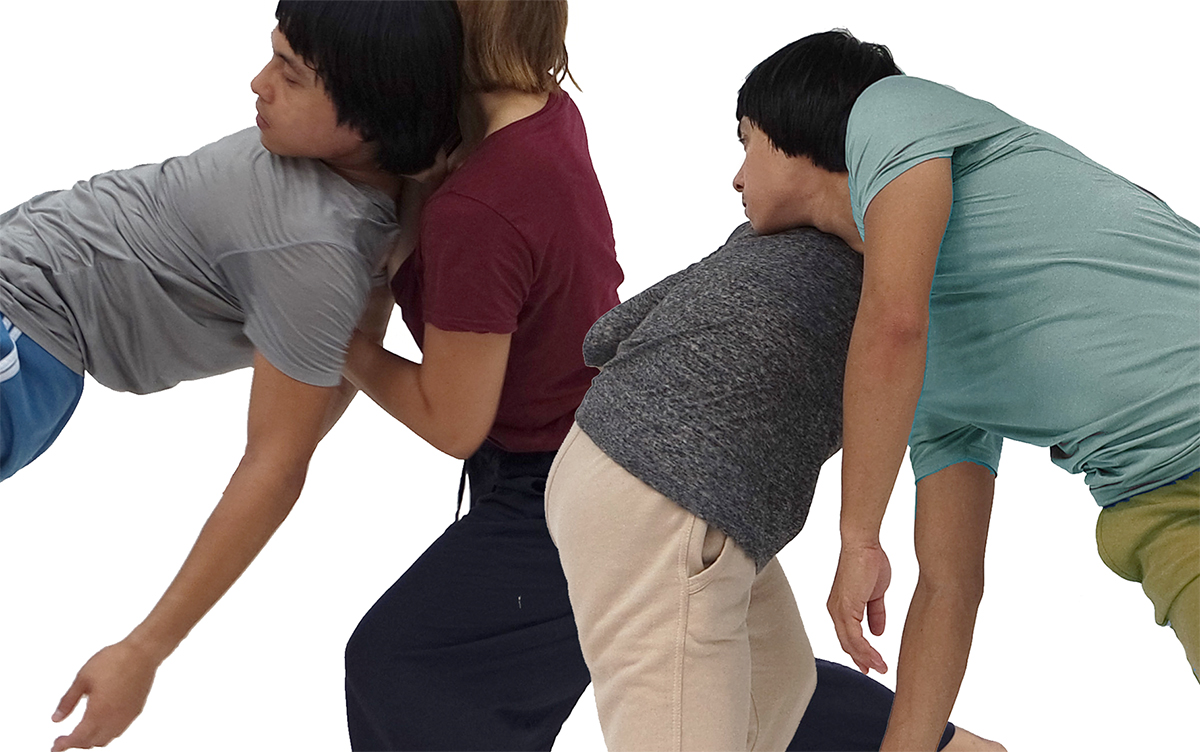
Close Company, Alison Currie & RAW Moves, image courtesy the artists and OzAsia 2018
RAW Moves and Alison Currie, Close Company
In Adelaide choreographer Alison Currie’s Close Company, a collaboration with Singapore’s RAW Moves and developed as part of OzAsia’s Asia-Australia exchange program Dance Lab, two dancers, Matthew Goh and Stephanie Yoong, undertake a ‘series of tests’ exploring the idea of co-dependency. Across three short but distinct parts they perform a restrained but dexterous choreography of connection and isolation, drawing together and pulling apart, mirroring each other from a distance or erotically embracing. Sometimes they simply observe or, for example when they check their phones, ignore each other. In the work’s final part the dancers thread their bodies into a single piece of clothing, something like an outsized T-shirt, and, in an arresting image of mutual dependence, take it in turns to carry each other around the space on their backs.
As each test is taken, bookended by the chiming of an iPhone alarm, Goh and Yoong — both the experiment’s facilitators and its subjects — gradually fill in a wall chart, each assigning a number from one to 10 to a range of variables: connection, intensity, pace, pressure, softness. As its name suggests, the work is an intimate experience, the dancers performing in close proximity to audience members who are able to move freely around the space, and are at one point invited to illuminate Goh and Yoong with the flashlights on our phones. Close Company is a modest work but one that, through its balanced modulation and effective twinning of the analytical and sensual, rewards the close attention it quietly urges.
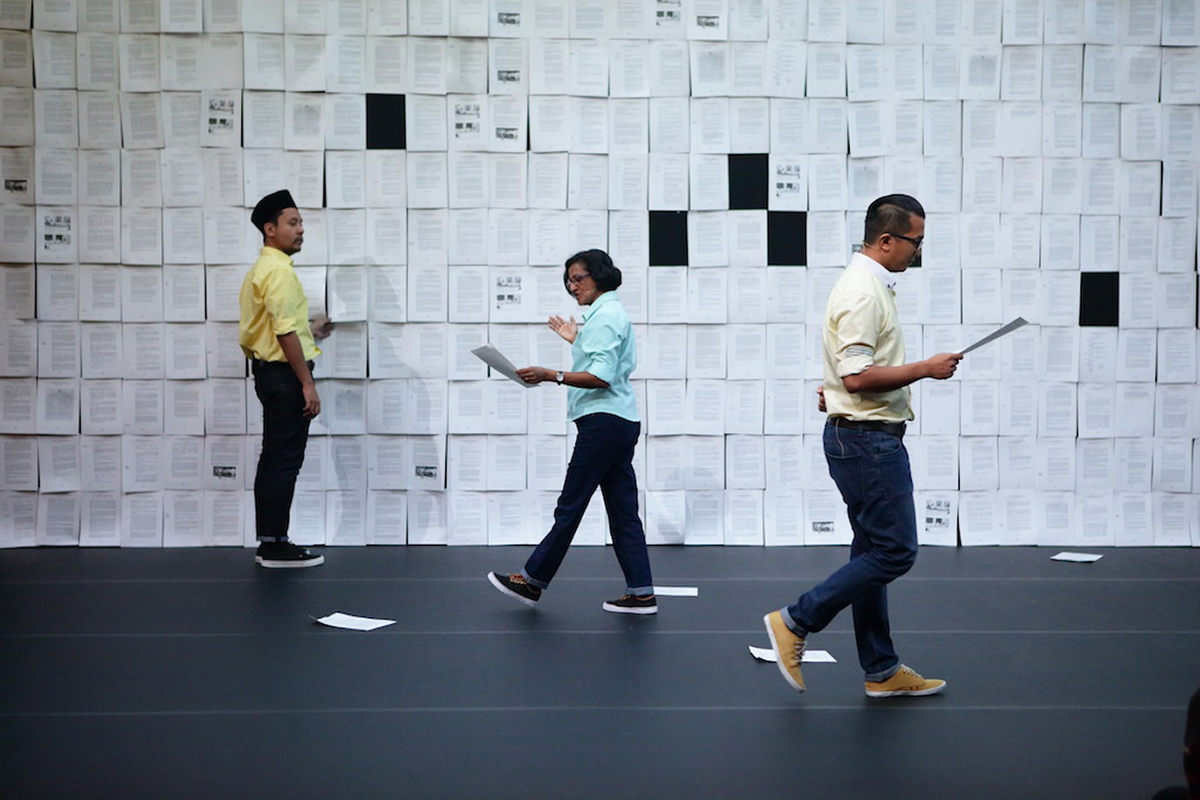
Baling, Asian Culture Centre, photo courtesy the artists and OzAsia 2018
Five Arts Centre, Baling
In December 1955 in Baling, a small north Malaysian town near the border with Thailand, British officials hosted a series of secret talks between Malayan Chief Minister Tunku Abdul Rahman, his Singaporean counterpart David Marshall, and communist leader Chin Peng, formerly a hero in the war against the Japanese, then the ‘most wanted man’ in the British empire. The aim of the talks was to end the seven-year-long revolutionary war dubbed the ‘Malayan Emergency’ by the colonial government, but they ended in a deadlock, albeit one that prefigured Malaysia’s independence from British rule two years later.
This fascinating if byzantine and largely forgotten episode in the mid-20th century’s wave of anticolonial and pro-communist insurgencies is, in Five Arts Centre’s Baling, transfigured into a measured documentary theatre performance based on publicly available transcripts of the talks, hundreds of printouts of which adorn one wall of the space from floor to ceiling. In a vivid illustration of the necessarily selective and incomplete nature of historical reconstruction, actor-researchers Anne James, Imri Nasution and Faiq Syazwan Kuhiri pluck individual pages down, reproducing the formal but impassioned tone of the talks, the participants in which they perform interchangeably.
In this way, and in the periodic moving of the audience to different parts of the space, our perspective on the theatricalised events is constantly shifting. The work’s interest, even when its textual and historical density threaten to overwhelm, lies not so much in its form — although, under Mark Teh’s astute direction, it’s enlivened by the projection of photographs and newsreel footage, and the interposing of the actors’ personal connections to Baling and its repercussions — but rather in the studious way it reanimates the gravity of the events. At stake is the fate of a nation, poised between violently opposed ideologies, and to be decided by charismatic men.
If Teh has an agenda it’s to rehumanise Peng, long made a bogeyman by the nationalists and still a contentious figure in present-day Malaysia (Kuhiri recounts an earlier performance of the Baling transcripts he was involved in that was monitored by Malaysian Special Branch, and afterward being attacked online as a communist sympathiser). The work’s quietly moving climax sees Nasution, also a documentary filmmaker, revisit footage of an interview he recorded with Peng, close to death and living in exile in Thailand. The clips were never used; in them, the old Malayan patriot seems far-gone, responding to Nasution’s questions with long, rambling answers or simply silence. One thing is clear: he aches to return home, a wish that was never granted but feels, however partially, redeemed by Baling’s sympathetic but never hagiographic portrait.
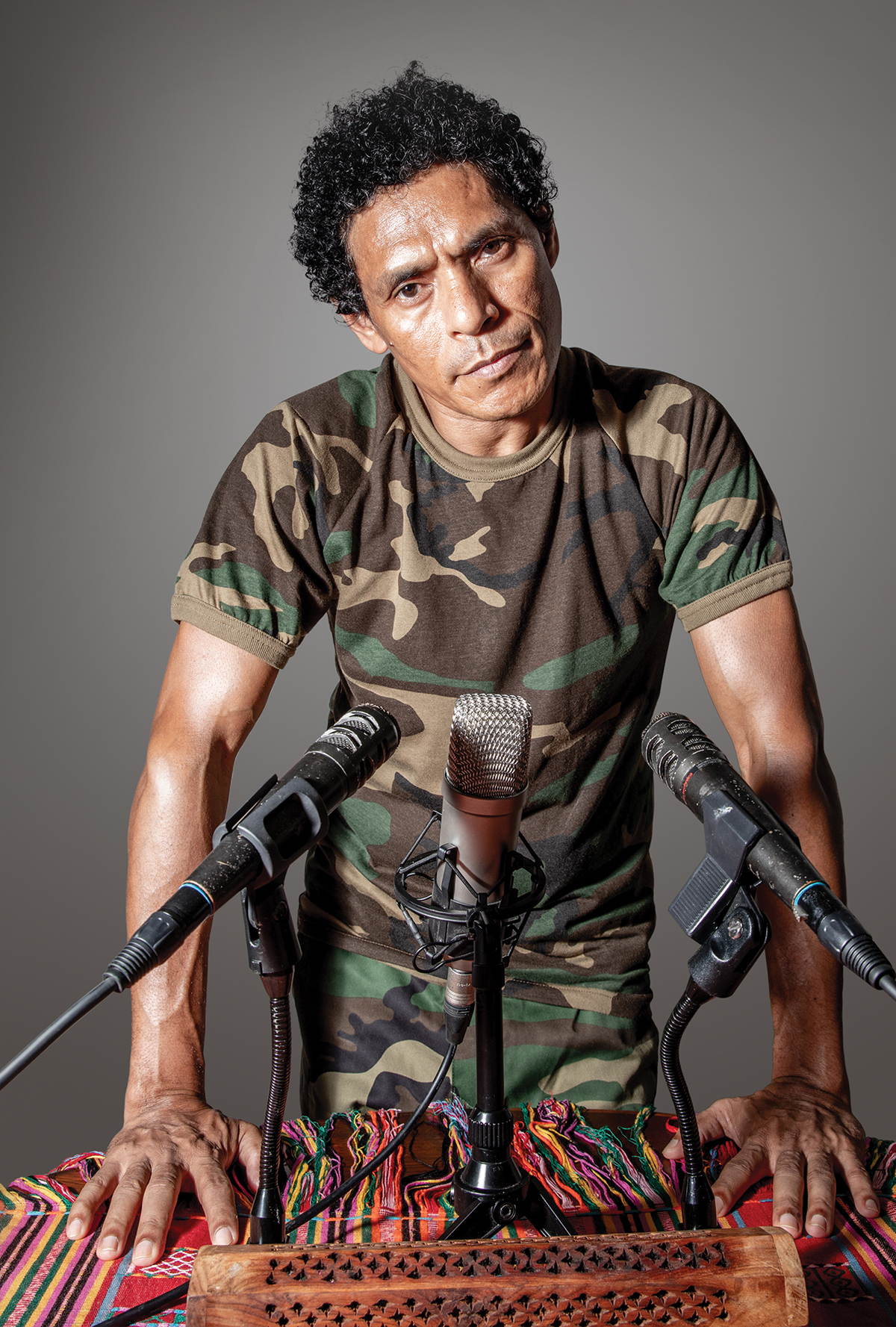
Jose Da Costa, Hello, my name is …, photo courtesy the artists and OzAsia 2018
Paulo Castro, Hello My Name Is
Adelaide-based director Paulo Castro’s Hello My Name Is… also shines a light on a little-known but still reverberating regional trauma, Indonesia’s bloody occupation of Timor Leste and particularly the 1991 Santa Cruz massacre in which 250 East Timorese pro-independence demonstrators were gunned down in a Dili cemetery. Similarly to Baling, the work resonates with personal connections to the events it depicts: actor Jose Da Costa survived the massacre and was imprisoned in its wake while, more distantly, Castro is implicated in the violence via the role of his home country, the former colonial power Portugal.
The work’s text, sitting somewhere between a polemic and a eulogy, is drawn from Edward Bond’s Choruses After the Assassinations, a brutally poetic treatise on the aftermath of war. “Children lose their parents,” says Da Costa, his delivery both haunting and haunted, “parents lose each other.” In a commendably restrained solo performance, he also gives voice to the forces that kill and destroy: “I am the army. My feet are tanks, my arms are guns.” He brandishes a pistol and wields a wooden cross like a machinegun.
But it is state rather than military actors that are painted most darkly here. Da Costa, dressed in army fatigues, sets up the stage like a meeting room for an international conference, assigning name plates to tables for the political figures involved in the events: Ali Alatas and Gareth Evans, the then foreign ministers of Indonesia and Australia respectively, and Xanana Gusmão, the Timorese resistance leader and later Prime Minister. Places are also reserved for ‘Independent Anonymous,’ represented by a human skull, and current UN secretary and former Portuguese Prime Minister António Guterres, an anomalous nod to Timor’s colonial past and, perhaps, a comment on the occupation’s ongoing significance. Da Costa scatters bones around the tables, and, with black irony, places an oil drum on Evans’ desk, and toasts the relationship between Australia and Indonesia with champagne. Finally, having wrapped himself in and then cast off both the Timor and Portugal national flags, he zips himself into a skeleton hoodie and lies down next to a makeshift shrine in solidarity with the dead.
Castro’s direction is deftly imagistic (he also designs the show’s lighting and sound, the latter comprising a repeated fragment of post-rock) but, as in much of his self-devised work, Hello My Name Is… feels dramaturgically flat, individual moments strikingly composed but failing to cohere into stronger narrative or thematic purpose. Nevertheless, it’s a work, anchored in Da Costa’s fine performance, that potently expresses the moral bankruptcy at the heart of empire-building, and the violent oppression and exploitation that continues its legacy in all but name.
Hotel Pro Forma, War Sum Up
Also a meditation on destruction and loss, War Sum Up by Danish company Hotel Pro Forma was, for many, the high watermark of this year’s OzAsia Festival. Reaffirming Joseph Mitchell’s interest in showcasing contemporary Asian opera — Japanese composer Keiichiro Shibuya’s ‘vocaloid’ opera The End appeared in last year’s program — it’s a work of considerable scale and interculturalism, requiem-like in its sustained atmosphere of grief and dread but thoroughly modern in its pop art-inflected hybridity.
Musically, the opera is elegiac, its score — the fruit of a seemingly unlikely collaboration between Latvian composer Santa Ratniece, French sound artist Gilbert Nouno and UK electro ensemble The Irrepressibles — feels indebted to sonorism, the tonal style typified by Henryk Górecki, György Ligeti and others, and often used (as in the films of Stanley Kubrick) to convey a sense of the horrific or numinous. Performed via laptop, with the Latvian Radio Choir under the baton of Sigvards Klav, the score is rich, textural and varied, cluster chords on violin blending seamlessly with electronic elements, cartoon sound effects and the voices of the 11 singers, plus solo soprano Ieva Ezeriete, who wear microphones.
Willie Flindt’s sparse, Japanese-language libretto (English surtitles are provided) makes use of Noh theatre archetypes, each emphasising the physical and spiritual desolation of war: the Soldier (Aigars Reinis), the Warrior (Gundars Dzilums), and the Spy (Ilze Berzina). Ezeriete, who sings with impressive strength and clarity, portrays the Gamemaster, a sort of power-suited politico who initiates the action by cranking out a sentimental melody on a music box; though the narrative is nonlinear and sharply modular, the harrowing stories of each character never meaningfully connect. The chorus — costumed by Henrik Vibskov in a kind of soft armour reminiscent of both Japanese warrior culture and the aesthetics of Steampunk — remains more or less static throughout, the four principals stepping out of tableaux-like groupings to sing their laments.
The work, staged on a two-tiered platform, is a visual cornucopia. Vast back-projections feature Hikaru Hayashi’s manga illustrations, diagrams of weapons and military vehicles, and, perhaps superfluously, gruesome black and white battlefield photographs. Projected text, slickly integrated with Jesper Kongshaug’s monochromatic lighting design, effectively undermines the libretto’s spare poetics with matter-of-fact litanies of PTSD treatments and spy lingo. Director Kirsten Dehlholm of Hotel Pro Forma assimilates it all superbly, and leaves us with a disquieting image of horror wrought from the everyday: the silhouette of a tank formed by a spotlight cast on a jumble of furniture. In such moments the work’s message doesn’t feel reducible to a simple ‘war is hell;’ it’s freighted instead with ambivalence, eliciting a kind of terrible wonder.
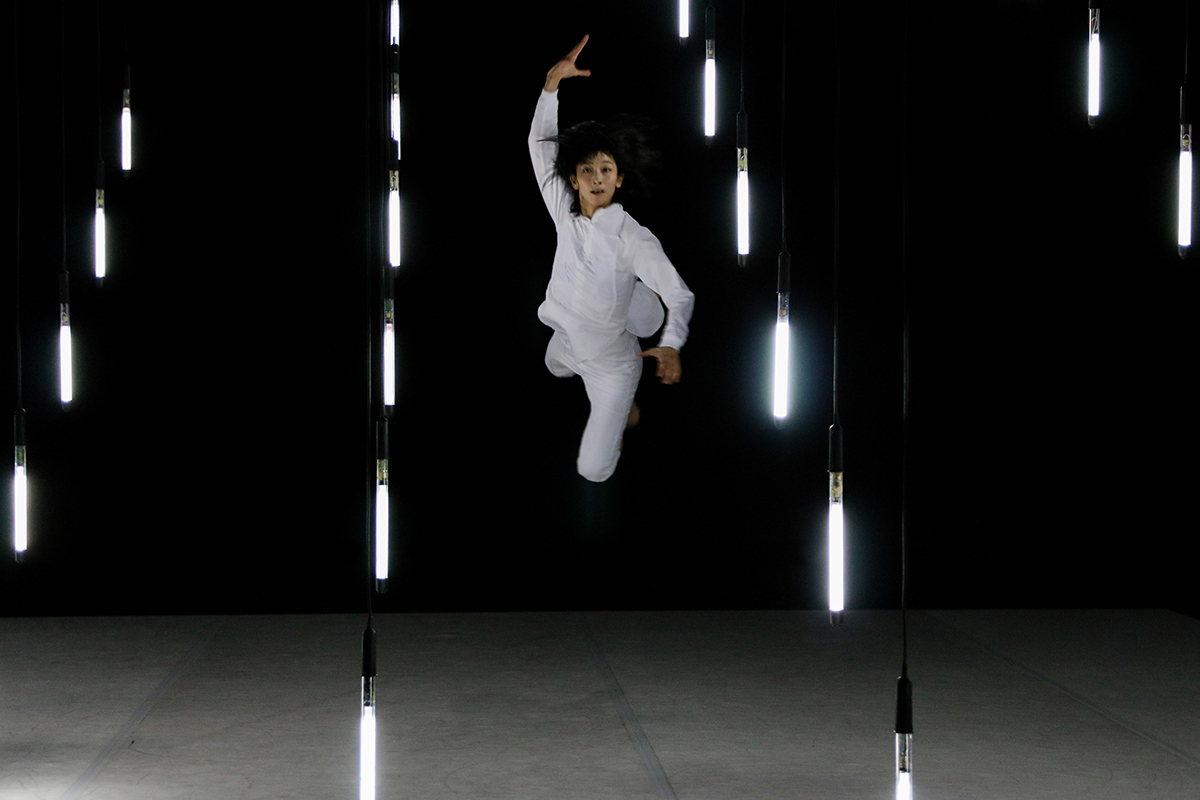
Yui Kawaguchi, Andropolaroid 1.1, OzAsia 2018, photo Elitza Nanova
Yui Kawaguchi, Andropolaroid 1.1
In Andropolaroid 1.1, Berlin-based Japanese choreographer Yui Kawaguchi also explores the intersection of the human and nonhuman, the potential for both transcendence and brutalisation in their meeting. Dressed in white and moving among husband Fabian Bleisch’s installation-like array of vertical neon light tubes suspended in two slanting planes, Kawaguchi performs a sort of duet with herself, imbuing the space with a sense of two distinct presences, one implacable and machinelike, the other all too human.
In the first part of the work Bleisch’s lights, synchronised with electronic pings, snap on and off singly and in clusters, creating shifting visual fields for Kawaguchi’s athletic, ballet- and hip-hop-inflected movements. Impeccably timed jumps under strobe lights leave her seemingly suspended in mid-air. A section set to announcements in Japanese and German, as in some uncanny transit lounge, hints at Kawaguchi’s growing estrangement from the world around her.
In the work’s second part she seeks something — shelter, comfort, a sense of belonging? — in a red hoodie dropped from the ceiling, alternatingly embracing and discarding it as pulsating dance music erupts with every touch. Having donned the hoodie she becomes manic, the formerly restrained choreography opening out into a new expansiveness as she wheels about the space (somehow mostly avoiding the overhanging lights) before finally becoming exhausted, or perhaps short-circuited, by it. Kawaguchi’s suddenly expressive face suggests a newfound oneness of the body — albeit, perhaps, still a post-human one — from which she had seemed perilously dissociated. It’s a quietly hopeful image.
–
OzAsia Festival 2018, Adelaide Festival Centre, 25 Oct-11 Nov
Top image credit: War Sum Up, Hotel Pro Forma, photo courtesy the artists and OzAsia 2018
Chiharu Shiota
I first encountered Chiharu Shiota’s dramatic artwork at the 2001 Yokohama International Triennale of Contemporary Art. Her Memory of Skin comprised a row of five muddy-brown dresses suspended from the high ceiling, each dress 13 metres tall and with a water pipe above it pouring cleansing water down its length. Standing at the foot of these dripping dresses that towered over the exhibition was a humbling and unnerving experience and it has haunted me since. So it was with great interest that I explored Embodied, the survey of her work shown at the Art Gallery of South Australia in this year’s OzAsia Festival.
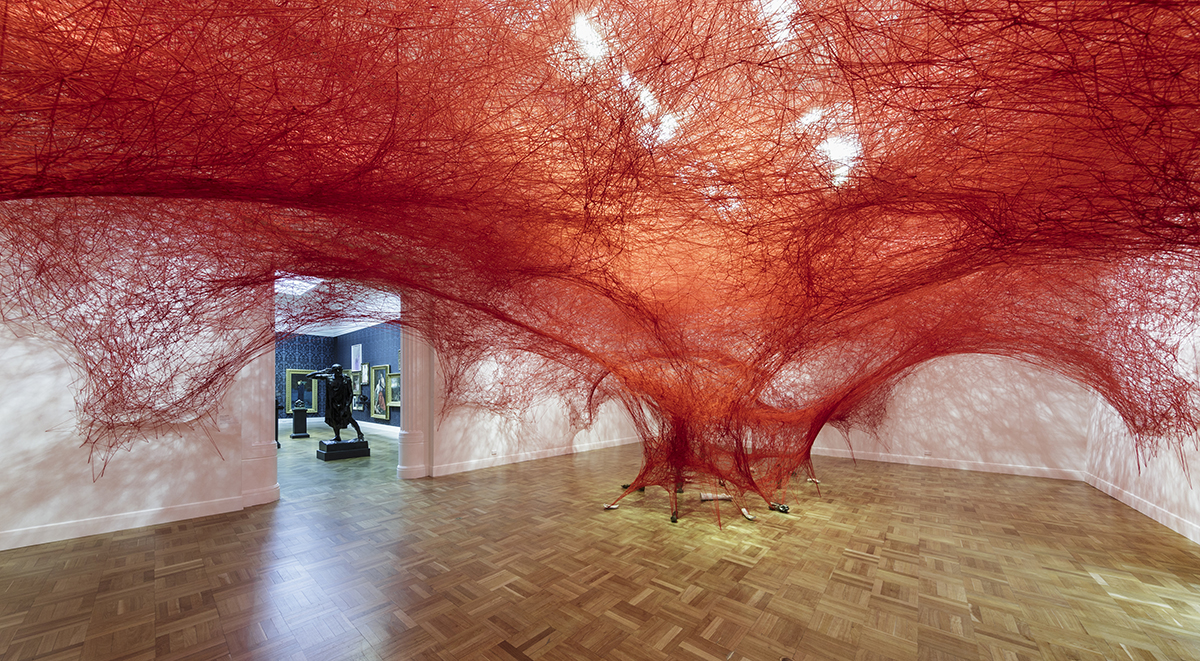
Chiharu Shiota installation, photo Saul Steed
The survey, including a newly commissioned installation, forms the centrepiece of OzAsia’s visual art program, exploring the 24 years since her seminal performance piece Becoming Painting — made in Canberra in 1994 — in which she wrapped herself in canvas and was splattered with red paint. The AGSA has documented her career with a substantial publication, Chiharu Shiota: Embodied, which contains insightful essays by AGSA curators Russell Kelty and Leigh Robb and independent curator Anais Lellouche, together with an interview with the artist. The book, bound with red string to echo Shiota’s use of such material, includes an image of Memory of Skin and other early work including drawings and video stills. A new work, entitled Internal, accompanies the AGSA survey — an array of three, six-metre long red dresses draped across the pillars of the AGSA’s neo-classical façade, again dwarfing the viewer and offering an irresistible taste of the extraordinary work within.
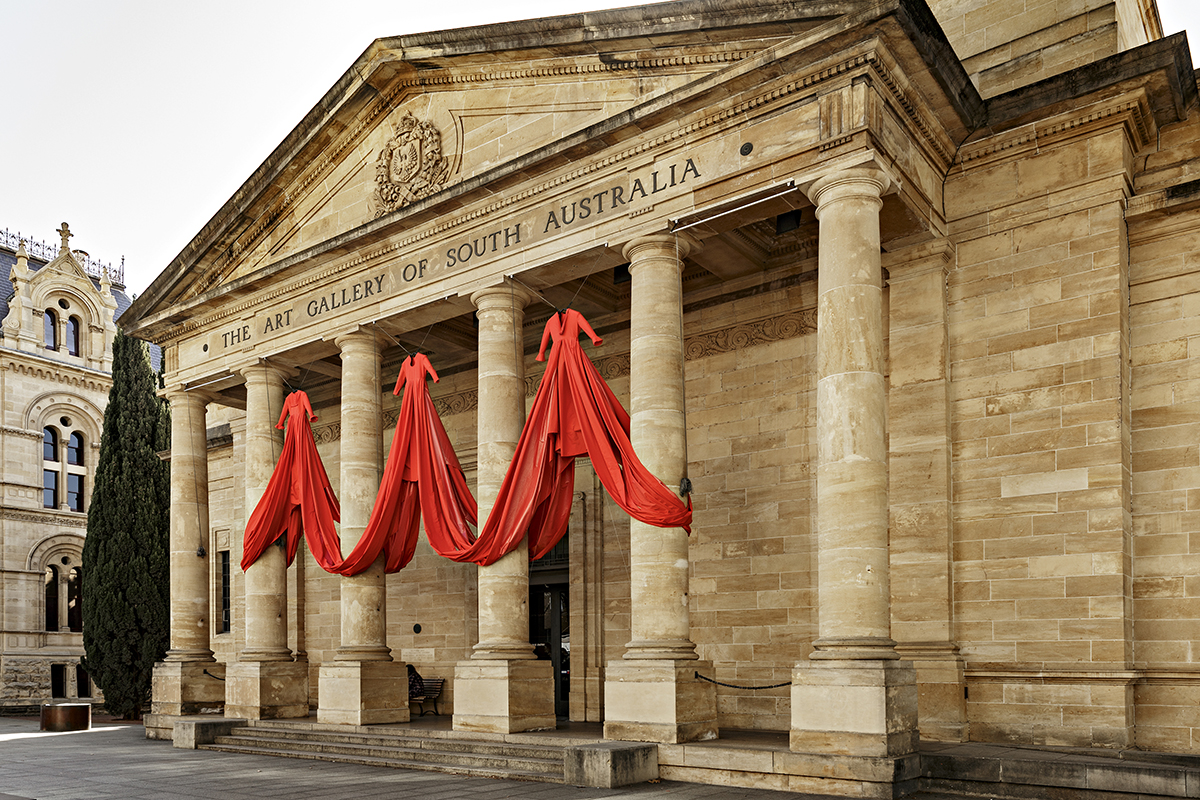
Chiharu Shiota installation, photo Saul Steed
Chiharu Shiota was born in Japan and studied art there but reconsidered her work following subsequent study at the ANU School of Art in the early 1990s, moving away from traditional forms of painting with which she had become disillusioned and into the field of performance and installation. Based in Berlin since then, her oeuvre has expanded over the years to encompass video and more recently bronze casting. The most overwhelming work at the AGSA is her Absence Embodied, a site-specific installation commissioned by the gallery and occupying an entire room, comprising a dense web woven from 180 metres of red woollen thread suspended from the ceiling and walls. The web is anchored to the floor by castings of body parts of the artists herself and family members including a bronze of three hands — her daughter’s, her partner’s and her own — clasped together and entitled Belonging (2017). She had been invited to make a work responding to the AGSA collection and, as that room is normally hung predominantly with figurative paintings, her intention with Absence Embodied was to evoke the absent figure. Shiota indicates that her string installations, which she first developed in Canberra, are a form of drawing in space and the colour red, which she uses frequently, suggests blood vessels. Absence Embodied envelops the viewer, creating the feeling of being inside Shiota’s circulatory system, the castings of limbs marking the extremities of her body; suggesting to me a body being torn apart.
Among the videos in the exhibition is Shiota’s 2010 performance Wall, in which she is shown lying naked and twitching on a bare floor smothered in many metres of clear plastic medical tubing filled with red liquid and accompanied by a soundtrack of a heartbeat, the work referencing her pregnancy. At times, her work suggests she feels trapped by the limitations of her body, and her health has evidently been an ongoing concern. Shiota says that her work cannot be separated from her body: “It is always the balance of this triangle of the art, the body and myself from which I am always making work” (Chiharu Shiota, Embodied, AGSA 2018). Her intensely personal and visceral work suggests an alternative awareness to Descartes’s “cogito ergo sum,” as if she is saying, ‘my body exists, therefore I am.’
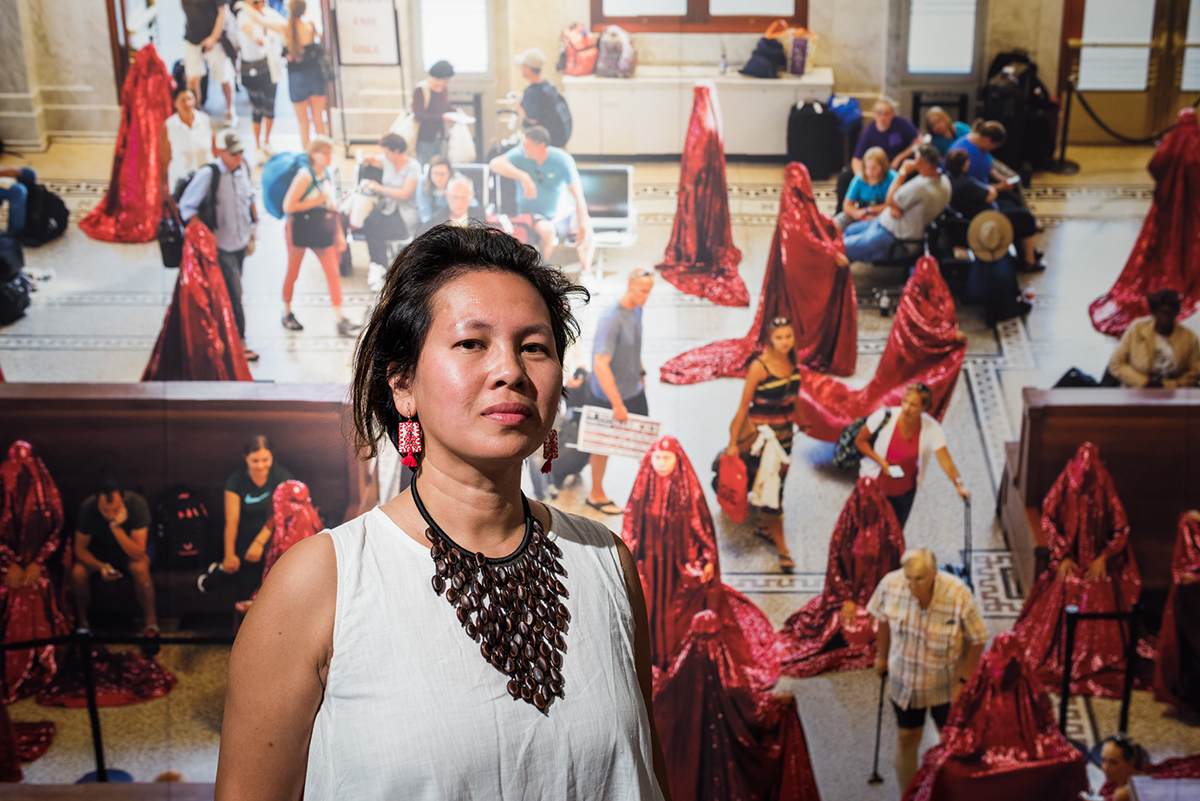
Opening, AGSA installation The Red Chador, Anida Yoeu Ali, OzAsia 2018, photo Daniel Purvis
Anida Yoeu Ali
Shiota is one of five female artists in OzAsia 2018 who originate from Asian countries and who consider the self and especially the body in widely divergent ways. Cambodian-American artist Anida Yoeu Ali’s The Red Chador: in Memoriam is an ongoing activist performance that has evolved since its inception in 2015. Ali created the Red Chador — a full-length chador covered in red sequins and sometimes masking her face — for public performances, drawing attention to the anxieties that the Islamic religion and dress codes provoke in the west. The chador’s colouring and the use of sequins are inconsistent with typical Islamic dress, distinguishing the artist’s appearance from that of other Muslim women and offering a conceptual challenge to curious onlookers. Over the course of Ali’s performances, the Red Chador has become a character, the personification of a refugee or a victim of authoritarianism or racism — a creation intended to mobilise opinion. She has enacted numerous performances around the world in which she appears silently in public wearing the chador. Having originated in Paris after the Charlie Hebdo incident, the Red Chador was well-received there but provoked often very negative responses in the US — in one instance, Ali had to abandon the performance, such were the threats to her safety.
The Red Chador subsequently disappeared (presumably confiscated) in transit from Israel in 2017 and her performances now take the form of memorialising its loss. For her Adelaide exhibition, Ali showed videos including The Red Chador: The Day After, which documents a performance in Seattle the day after the 2016 US Presidential election, together with a series of photos of herself wearing the chador in public performances and a series of framed texts such as “Ban Me” and “I am a Muslim” used in placards in those performances. Her installation included memorial wreaths and an altar, copies of a newssheet reporting the history and loss of the Red Chador were available and at the exhibition opening she delivered a eulogy for it
and invited audience participation by making offerings of incense. Presumably Ali could make a new garment but instead has used the Red Chador’s mysterious disappearance, equating to the abduction of a person, as an extension of the original concept, now evidencing an attack on free speech.
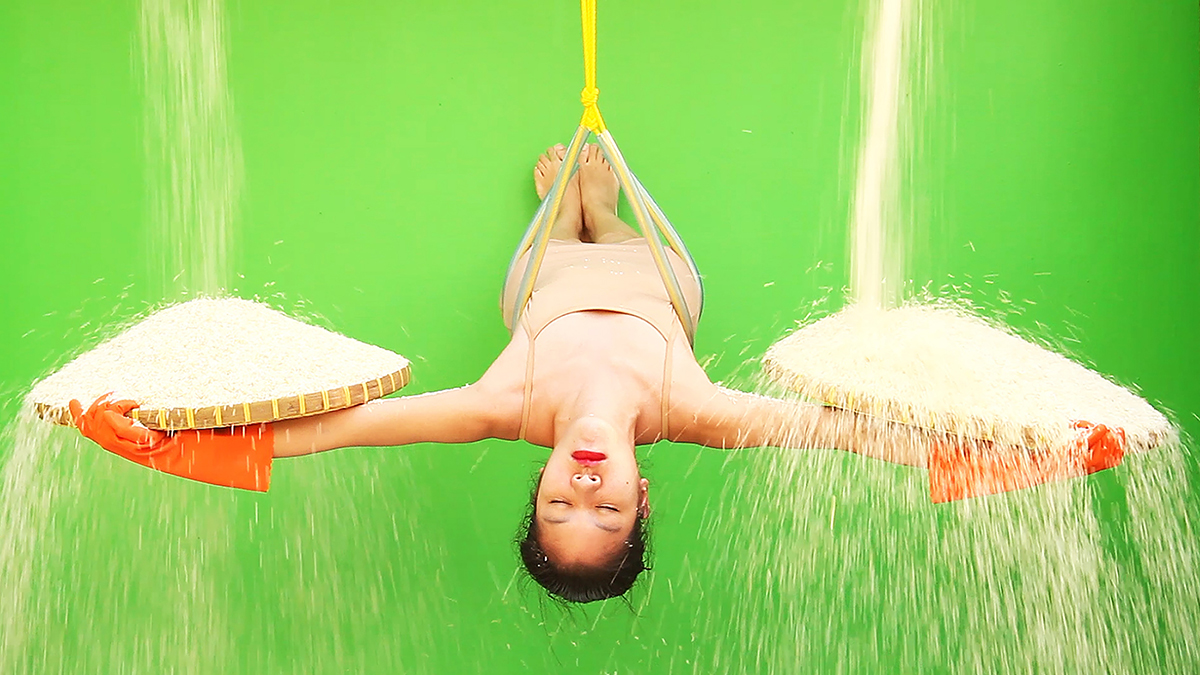
The Scale, Kawita Vatanajyankur, OzAsia 2018 photo courtesy the artist
Kawita Vatanajyankur
Thai-Australian performance artist Kawita Vatanajyankur uses her body in physically demanding ways to characterise Thai women’s oppressive working lives. Her exhibition, The Scale of Justice, comprises a series of short, visually arresting and highly compelling videos in which she deploys her body to represent objects or tools used in mechanical processes, for example as a set of scales to weigh rice or vegetables (The Scale 2, 2016) or as a juice squeezer (Squeezers, 2015). In The Scale of Justice (2016), she balances her outstretched body on a horizontal beam and supports a basket of vegetables hanging from her neck and another basket hanging from her feet. As more vegetables are thrown from off-camera into one or other basket, her body tilts one way or the other. Vatanajyankur sees her performances as a form of meditation, pushing her body through pain limits to lose herself and merge with the objects and processes being depicted. Her extreme form of performance raises issues beyond the exploitation of labour or gender, asking what it is to be human, and recalling the exhaustive performative efforts of artist Marina Abramović. However, Vatanajyankur does not have to labour to survive as do the exploited women labourers to which her work refers — she does so by choice rather than necessity. Her work condemns exploitation — the invisible, controlling forces off-camera — rather than labour itself, and she implicitly invites viewers to empower themselves by transcending physical pain and their own sense of self. (See selected video works here.)
JeeYoung Lee
South Korean artist JeeYoung Lee exhibited a series of large-scale images that take tableau photography into new territory. She creates imaginary scenes and then photographs herself within them, her scenes suggesting bad dreams in which the dreamer is lost in a strange world and faces imponderable conundrums or existential threats. In My Chemical Romance (2013) she is seen trying to find her way through a forbidding maze of steaming water pipes painted in the black and yellow colours of construction-site barriers, as if she is lost in an industrial plant. In Resurrection (2011), she sits inside a flower in a pond looking like a newborn water sprite, the image suggesting she has escaped civilisation and returned to nature. In Gamer (2011). a male figure is dwarfed by oversized Lego bricks with which he is building a structure, suggesting that he is the artist’s online avatar, creating his own world. While her work may appear whimsical, it offers metaphors for the difficulties of contemporary life. Positioned opposite the display of JeeYoung’s photos is an installation — a double bed in a field of pink cotton-ball flowers above which hover artificial butterflies — that resembles the kinds of scenes created for the photos. The empty bed invites us to imagine occupying this fantasy space and her other spaces and to reconsider the world we have created for ourselves.
The titles of JeeYoung’s works are crucial to their appreciation and unfortunately the Festival Centre did not provide a caption or plaque indicating the title of each work, obliging interested viewers to search for the works online to discover their titles. Some of Kawita Vatanajyankur’s videos were also shown at indoor and outdoor locations around the Festival Centre, extending their public visibility, but they too were uncaptioned and were screened alternately with material publicising other events, risking their significance being lost on passers-by.
Yee I-Lann
Kuala Lumpur-based Yee I-Lann’s Like the Banana Tree at the Gate (2016) is a photo-collage showing a row of standing and seated women in various poses, some holding banana palm leaves and all with their faces obscured by very long hair. Some figures appear more than once as if they are doubles or multiples of the same individual. Yee’s work references traditional folklore to create a general metaphor for female power and more specifically for feminist movements in Malaysia and elsewhere in Southeast Asia. The catalogue essay informs us that these female figures each represent a Pontianak, a female spirit of Yee’s native Borneo that inhabits banana trees, and that the work’s title refers to “a 17th century sultan in southern Borneo who advised his subjects not to plant a banana tree near their front gates so as not to advertise their wealth to potential colonial exploiters,” the story have since been cited as an early form of resistance to colonisation. The figures in the photo-collage are in western-style casual dress to which viewers can easily relate and suggests that these female spirits are ubiquitous. Collectively they can be seen as a defensive force guarding traditional Bornean culture and sovereignty.
Performative unanimities
The female artists selected for this component of OzAsia all have major international reputations and showing them together enables illuminating comparisons, with a primary focus on performance and on the female body as a site of self-understanding and self-realisation. Shiota’s cathartic 1994 performance Becoming Painting was a turning point for her and resonates with the meditative performance work of Kawita Vtanajyakur, which involves risk-taking as a pathway to personal transformation. Anida Yoeu Ali’s daring public performances involve risk-taking as a means of encouraging social transformation. JeeYoung Lee’s performances in her imaginary spaces may be less risky physically or politically but equally encourage viewers to consider the controlling forces of their own worlds.
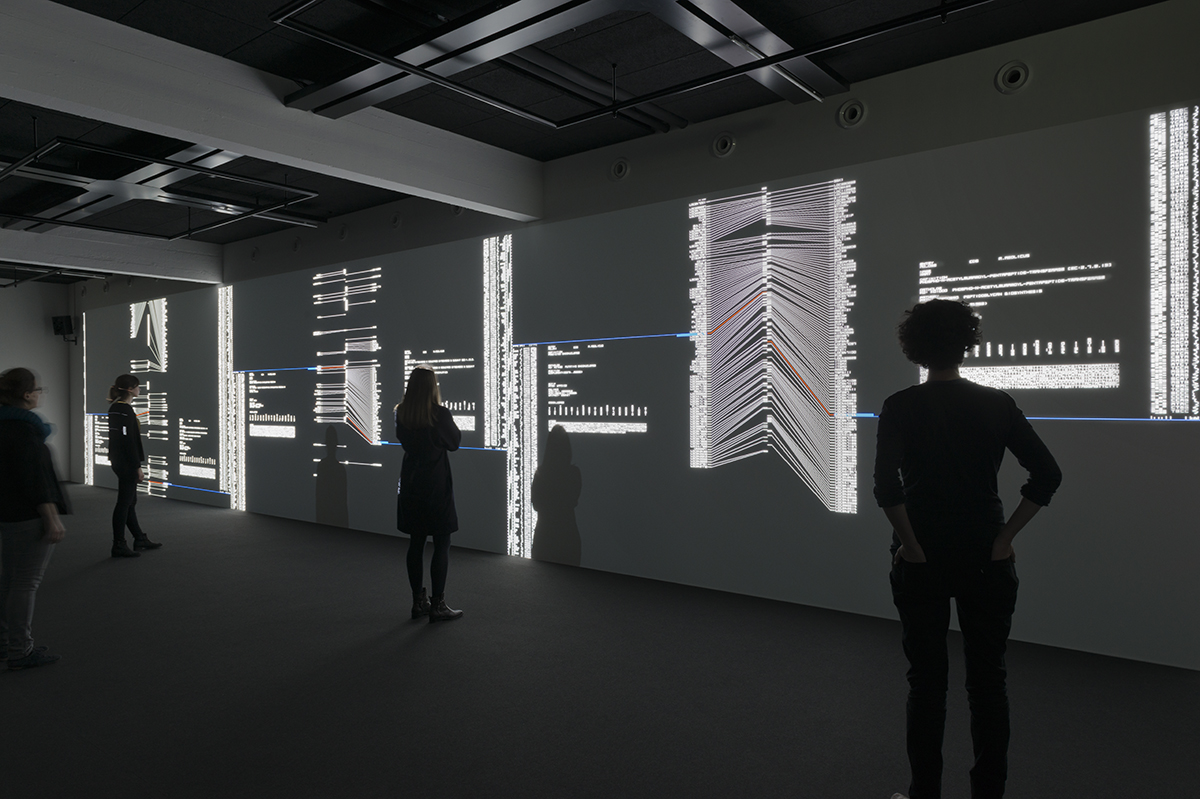
data.tron (3K version), audiovisual installation, 2014, (c) Ryoji Ikeda, photo Jana Chellino, courtesy HeK
Edo Style 1615-1868; Ryoji Ikeda, data:tron [3K version]
The OzAsia Visual art program also included two very different exhibitions providing notable contrasts to the work of the five female artists — Edo Style: 1615-1868, an exhibition of Japanese art of an era that provides a window to a long-lost, isolationist culture in which social customs and women’s roles were very different from those of today’s Japan; and renowned Japanese artist Ryoji Ikeda’s visually overwhelming and highly cerebral video and sound installation data:tron [3K version], which presents at hypnotic speed a seemingly infinite amount of numerical data, as if everything in the universe is ultimately reducible to numerals, codes or mathematical formulae. The inclusion of these exhibitions creates a sense of historical development, showing where we have come from and where we might be headed. While the OzAsia visual art program has no overarching theme and sensibly does not attempt the impossible task of surveying the art of the Asian region each year, it does highlight its breadth and depth, and in this program, it especially highlights the concern of women artists with female identity and empowerment and the evolving roles of women in increasingly globalised cultures. OzAsia reveals this cultural and political evolution through the inclusion of exemplary exhibitions by leading contemporary artists.
–
OzAsia Festival, 2018: Chiharu Shiota, Art Gallery of South Australia, 24 Aug-28 Oct; Kawita Vatanajyankur, Nexus Gallery and Adelaide Festival Centre, 11 Oct–9 Nov; Anida Yoeu Ali, JeeYoung Lee, Yee I-Lann, Adelaide Festival Theatre Gallery, 24 Oct-30 Nov; Edo Style: Art of Japan 1615-1868, David Roche Foundation, 5 Sept–1 Dec; Ryoji Ikeda, Artspace Gallery, Adelaide, 24 Oct–11 Nov
Top image credit: Opening Art Gallery of SA, installation by JeeYoung Lee for OzAsia 2018, photo Daniel Purvis
Drama to postdrama
I cut my teeth for RealTime with an interview with playwright Deborah Levy (RT 11, p6 1996). Levy, who has since gone on to a successful career as a novelist, had reached a personal crisis point in theatre. “Theatre is obsessed with explaining every moment and its causation in a way that doesn’t interest me much,” she explained. “I’m not in the least bit interested in narrative in the theatre. I really don’t come to the theatre to be told stories that the playwright already knows.” These insights may seem outdated now but in the 90s they were still challenging. She veered away from the naturalistic, political dramas of her early career and wrote a series of non-naturalistic texts, such as The B-Files, in which, as I wrote, “any sense of gender essentiality or an individual authentic self are undermined during the fluid investigations of identity.”
Born in South Africa of Jewish and Protestant parents, brought up in England, Levy saw herself as “stranded between all those points with all of them trying to claim me as theirs. The idea that there is a pure culture in our contemporary world is totally untrue. Our society is impure — no wonder cultural identity is what everyone is talking about.” She was driven to jettison both ‘narrative’ and ‘character’ as being too overdetermined for her shakily determined world. “Naturalistic characters always come on the stage with too much baggage. They rarely allow the audience space to project onto. That’s why I prefer working with persona.”
These shifts in focus in theatre — from dramatic narrative to ‘distilled images,’ from deep character to swiftly transforming persona, from coherent identity to fluid multiplicity, from representation to presentation etc — were not new. Artists in Europe, Britain and the US had been moving in this direction for a couple of decades. By the time of my interview with Levy it was becoming clear that, as she put it, drama was a “dead and dying form that sits very uncomfortably with any kind of expression of the contemporary world.” However, in looking back at the shows I watched and wrote about for RealTime over the following 14 years, it seems to me that this uneasy terrain was still the one being explored and fought over in most of the works; and that the ones I found the most interesting included within their dramaturgy the terms of the conflict they engaged.
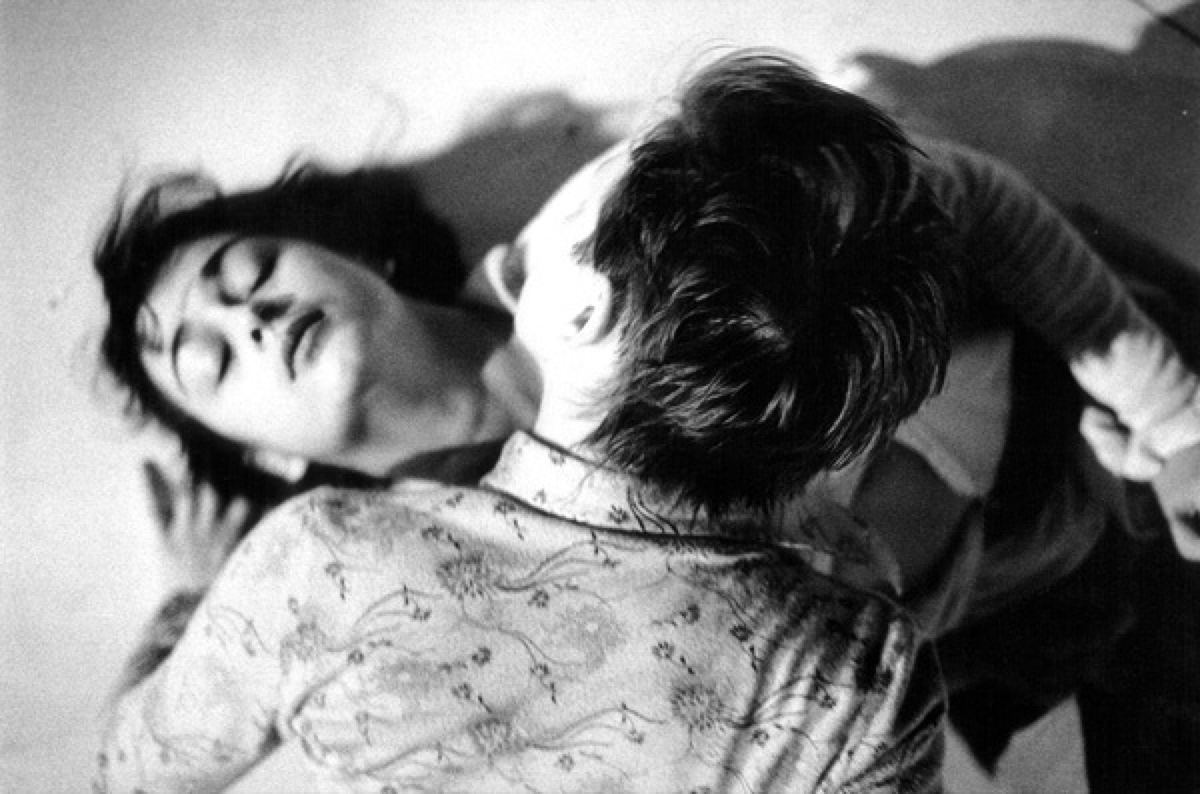
No-one is Watching, Meg Stuart & Damaged Goods (1996), photo courtesy the artists
Meg Stuart, No-one Is Watching; Saburo Teshiwagara, I Was Real — Documents
It’s not surprising that my first two examples come from that liminal world where dance approaches theatre (“Tanzteater,” Pina Bausch called it in the 80s), avoiding theatre’s ‘dead and dying form,’ bringing to it fresh investigations of the human through a heightened sense of the power and fragility of the body in space, and the perspectival shift of alternating stillness with barely controlled action-image. “Meg Stuart and Damaged Goods’ No-one is Watching takes place in an epileptic world,” I wrote from the 1996 Adelaide Festival. “The psyche, the society, the civilisation has been seized and is convulsing. Attempts are made by one or occasionally two of the figures within to connect with another, to express an emotion which has something to do with tenderness. Unfortunately, at the time, the intended receiver is not watching, possessed by a force that has little to do with love.”
The performance balanced on the fine line between the representation of a human condition and the shock of clear and present actions. “The dance for me was at its most powerful either in the fragments of states of being when no complete image was achieved or in the moments of suspension of action when the stage was filled with the memory of past events, or with the threat of what was to come. It was least interesting when dance became representational and traded off the audience’s empathy with what was being represented. It is always hard to watch madness being acted.”
Even the title of Saburo Teshigawara’s I Was Real — Documents (London International Festival of Theatre [LIFT] 1997) flirts with the desire for personal narrative (is this to be a story of someone’s life?), the promise of the real in an arena of pretence, and the confusion between represented past events with palpably present actions. “Documents of the time when I was real — for I am no longer?” I mused at the time. My memory of the piece now (and it has had a lasting effect upon me) is of its spareness, its sense of extended time and space, its magical configuration of human figures seemingly out of emptiness. “There are many dancers in Teshigawara’s company but the stage never seems crowded, the tendency always is towards emptiness, or clear focus upon one or two items. As a viewer, I am gently given the choice of entering and following, so that imaginatively I am travelling too.”
The work began simply and instilled its surreal world without effort. “Four men enter, put on berets then leave, enter, put on berets then leave, enter, put on berets then leave — no, one stays behind, fascinated with the moment of picking up the beret, bends, holding pose. This is the telescopic process that dream and memory utilise.” Teshigawara’s dancers were not dancing in any way that was familiar as dance. They were humans occupying space and forming images that triggered fleeting memories, and that suggested for performance ways of being present without needing justification from a rational narrative context.
Jan Fabre, I am Blood
Jan Fabre’s I Am Blood (Melbourne Festival, 2003) proved to be the extreme measure of the disturbance that the postdramatic could stir in the defenders of a coherent dramatic world view. I entitled my response to the show “The Anxiety of Formlessness,” and quoted the reviewers from the Melbourne dailies who reacted in horror, accusing it of lacking “any sense of selectivity, of form and structure, resulting in an indulgent presentation” (The Age), so that it presented only “a spectacular display of chaotic nastiness…poorly choreographed…a bloody shambles” (The Sunday Age). I agreed that I am Blood, and the shows by Teshigawara, Needcompany and Romeo Castellucci, works that I had written about for RealTime over the preceding years, “are not easy to absorb, impossible to fit into any recognisable structure. They feel carefully fashioned but without any underlying form; and maybe (horror!) this equates to surface without soul.”
My response was to meditate not upon the elements of traditional drama that the show was missing but upon what we saw before us and what it might provoke in us: “The show seems as much as anything to be a meditation upon the act of shedding and covering. The bodies cover themselves with armour, wedding dresses, ordinary clothes, only to take them off again and again revealing the vulnerable flesh (and blood) underneath. Steel tables are alternately used as platforms for human display and surgical benches for bodily desecration. I think of the jeeps and tanks and helicopters in Iraq, supposedly providing armoured protection to the ‘invulnerable’ US troops, but ripped away increasingly by bombs and missiles to expose the flesh of the soldiers underneath.” There was careful dramaturgical choice here in its “images and sequences of exquisite formality, set against sequences of seeming chaos.”
In his response to the irrational juxtaposition in shows such as this, Hans-Thies Lehmann coined the term “the aesthetics of poison.” He intended the term in a homeopathic sense: “An image of beauty, craving and desire is presented, but with the addition of a disturbing element, a vivid poisonous green tinge of colour…(which) spoils my enjoyment, while at the same time stimulating it to reach a different level of reflection.”
Being a Writer for RealTime
I had avoided reviewing theatre before I started with RealTime. How could I as an artist struggling to get my own stuff on the boards presume to assess the work of my fellow-artists? Keith and Virginia had from the outset cleared me from that concern: writing for RealTime was not to be a judgement of the work but a writerly response to it, allowing the show’s affect upon me to challenge me to write to it and thereby to open out into new associative musings. I learned on the job, mainly through the models provided by Keith and Virginia and other key writers in their own articles through the 1990s, particularly in the hothouse that was the RealTime daily response to the proliferation of the shows at LIFT97.
“I am aware of the ‘narrow grooves’ of my responses to the body of LIFT,” I wrote at the time, borrowing the metaphor from Paul Carter, “and of the danger that will drain its spirit. I see the inflexible fences I build across the irregular surface of a show, enclosing it in a way that is never healthy because it halts the drifting quality of a work of art.” It was the co-presence of other writers writing on the same shows (and others) that heightened my awareness. “As I read the articles of my fellow writers on the same event, I am led to reflect again upon what I might have written (or might have seen). ‘How do I see?’ has been ‘How do I write?’ for all of us as we steer clear of trenches already dug. We are saved by the diversity of cross-opinions. In fact, the writing of Linda [Marie Walker], Zsuzsanna [Soboslay] and Virginia [Baxter] often has for me the quality of a drift lane, not digging anywhere too deep, more interested in the ground beneath their feet as they travel.” Two thoughts arise from this experience.
1. Community
First, I felt again the power of community in art at the five-hour conversation between writers for the paper and artists at RealTime in real time at Carriage Works in October. I felt it for the first time as a writer at LIFT97 when our group of Australian writers joined up with several British writers to respond to the festival. More than anything, it was the opportunity to publish alongside one another a variety of responses to many of the shows: four different responses, for example, to Deborah Mailman and Wesley Enoch’s overwhelming 7 Stages of Grieving set alongside one another, each one a gem of writing, each finding new insights into the show to bring forth. What more could an artist want?
When occasionally I found myself disliking a particular show and trying to write to that response, I would discover in the same issue, several other articles discovering in the show delights and insights I had completely overlooked. One of the British writers (Gabriel Gbadamosi) attacked the Australian writers for their “hunger for an aesthetic” in our mainly positive responses to the German show Stunde Null. Whereupon, the following article by Keith included, in his positive response, a comment on Gabriel’s “quotable, cutting, epigrammatic style more in line with conventional British theatre reviewing.” These good-natured disagreements and agreements created within the paper the kind of productive dialogue out of which new ideas and new work can arise. Such a community of arts writing is to be treasured as our culture atomises by the day. In RealTime, the possibility was fulfilled.
2. Art and writing
The second thought has to do with the interplay between art and writing about art; or more specifically, the effect that a show could have on the very writing style of the responder. This was true throughout RealTime’s history — films, visual art, sound installations, performances: all drew from the writers writing that may not have been possible without the show as stimulus. In other words, what RealTime encouraged was not to trap every artwork in the tight, narrow language of ‘the review,’ or even ‘the academic interpretation,’ but to broaden the scope of the language of response in the light of the artwork’s unique act of communication. Many of the writers come to mind, but as an artist my joy has been that my own works have stimulated, for example, Jonathan Marshall to such powerfully poetic prose in his responses to two of my works, The Inhabited Woman and The Inhabited Man.
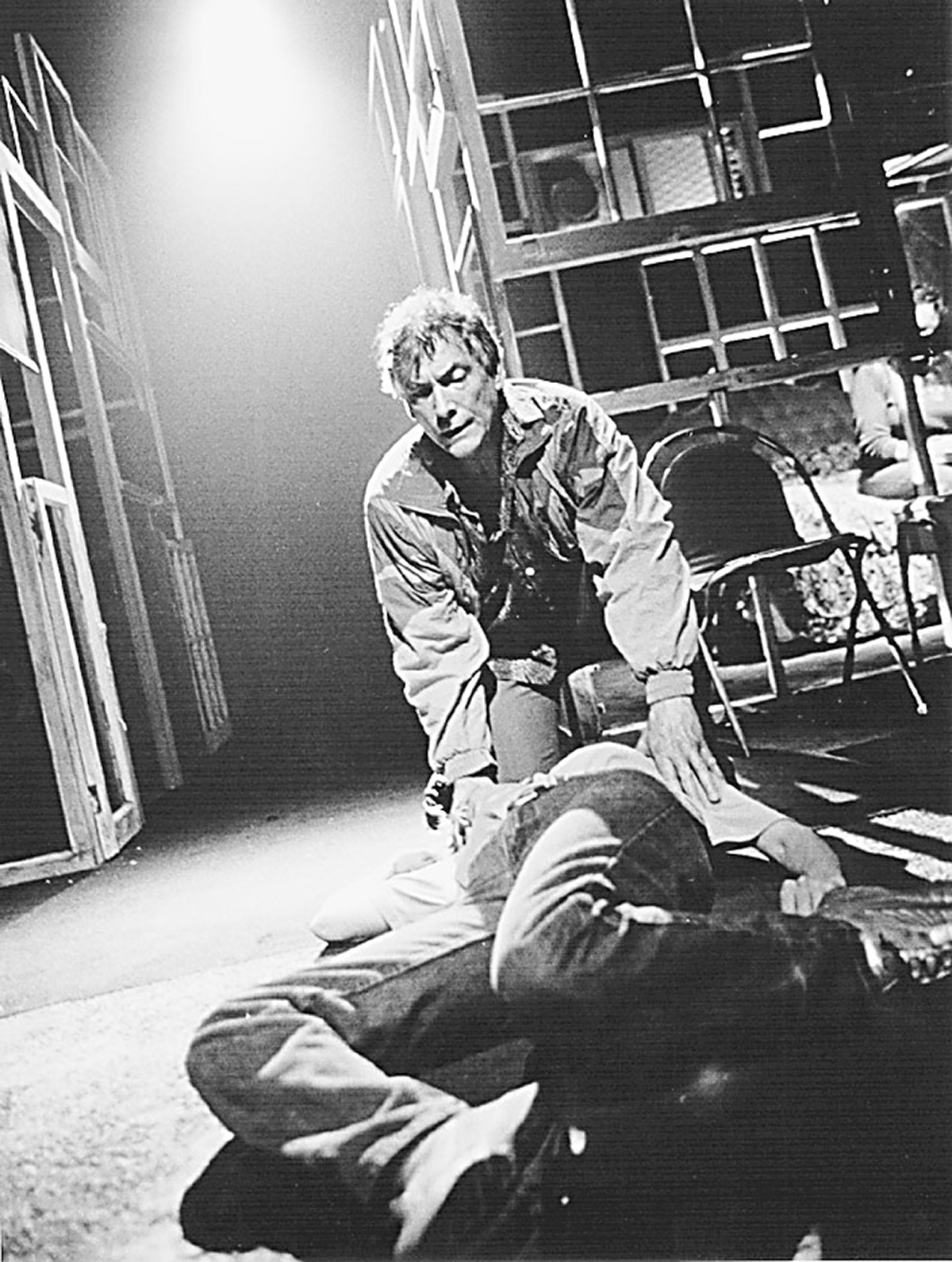
Ian Scott, Anne Browning, Slow Love (2002), Chamber Made Opera, photo courtesy the artists
My favourite example, however, has to be “From the cutting room floor”, the response penned by Virginia and Keith to the production of my play Slow Love at the Adelaide Festival in 2000. The play consists of hundreds of very short images separated by hundreds of blackouts. It is fragmentary and impressionistic and was my attempt at what I called “epileptic writing.” Their written response is a remarkable piece of epileptic writing in its own right. I delight in the article not because it simply praises the show; they include across the range of their fragmentary thoughts their own responses, the moments that remain with them, the lacks in show and production that they felt throughout, the associations they make to the wider culture, the responses of other writers, quotes from the show etc. It is an article that responds to the show by putting itself in the frame of mind that infuses the show itself. As co-writers, they transformed their style of writing; they allowed the art to create the language with which to write about it.
Politics and art/Politics in art
The conversation at the end of the afternoon at RealTime in real time ended on a rather sombre note — participants filled with trepidation about the future of art, especially performance, in these days when the political scene admits less and less room for Art in considerations of state. I thought back to other periods in my life when this had seemed to be the case: the Menzies years, the Fraser years, the Howard years, even the Hawke years. And my mind was drawn to certain of the shows that I have seen for RealTime, and the ways in which they have pushed politics to the forefront of the art in the face of lack of heed or outright hostility towards Art on the part of the politicians in power.
In 1996, shortly after THAT election when Howard defeated Keating, the Maly theatre from St Petersburg arrived at the Adelaide Festival with Claustrophobia. “On the night of the election,” I reflected (March 1996), “we were urged by politicians of both sides to count our lucky stars that we lived in a smoothly functioning democracy where a change of government can take place peacefully and without a drop being spilt. Well, yes. But something in me screams that we have allowed the reactionary party to crunch into power without a bang and with hardly a whimper.” Enter the young performers from the Maly, caught at a point when Russian society was going through its own painful transition from Communism to…what? “The overwhelming feeling,” I wrote, “is of a trapped generation, weighted down by the past, trapped in the present.” The point is that this lost generation took it on: tried to find a way artistically to express the disconnect between them and those in power, “beating out through the walls only to climb back in again to continue the fight.”
I remembered, too, the determined commitment of Australia’s Not Yet It’s Difficult (NYID) with their terrifying version of state control in K, and their chilling depiction of surveillance techniques in Scenes of the Beginning from The End. I subtitled my article on that company “The Danger Zone,” and marvelled at its consistently “merciless exposés of certain tendencies in contemporary civilisation.”
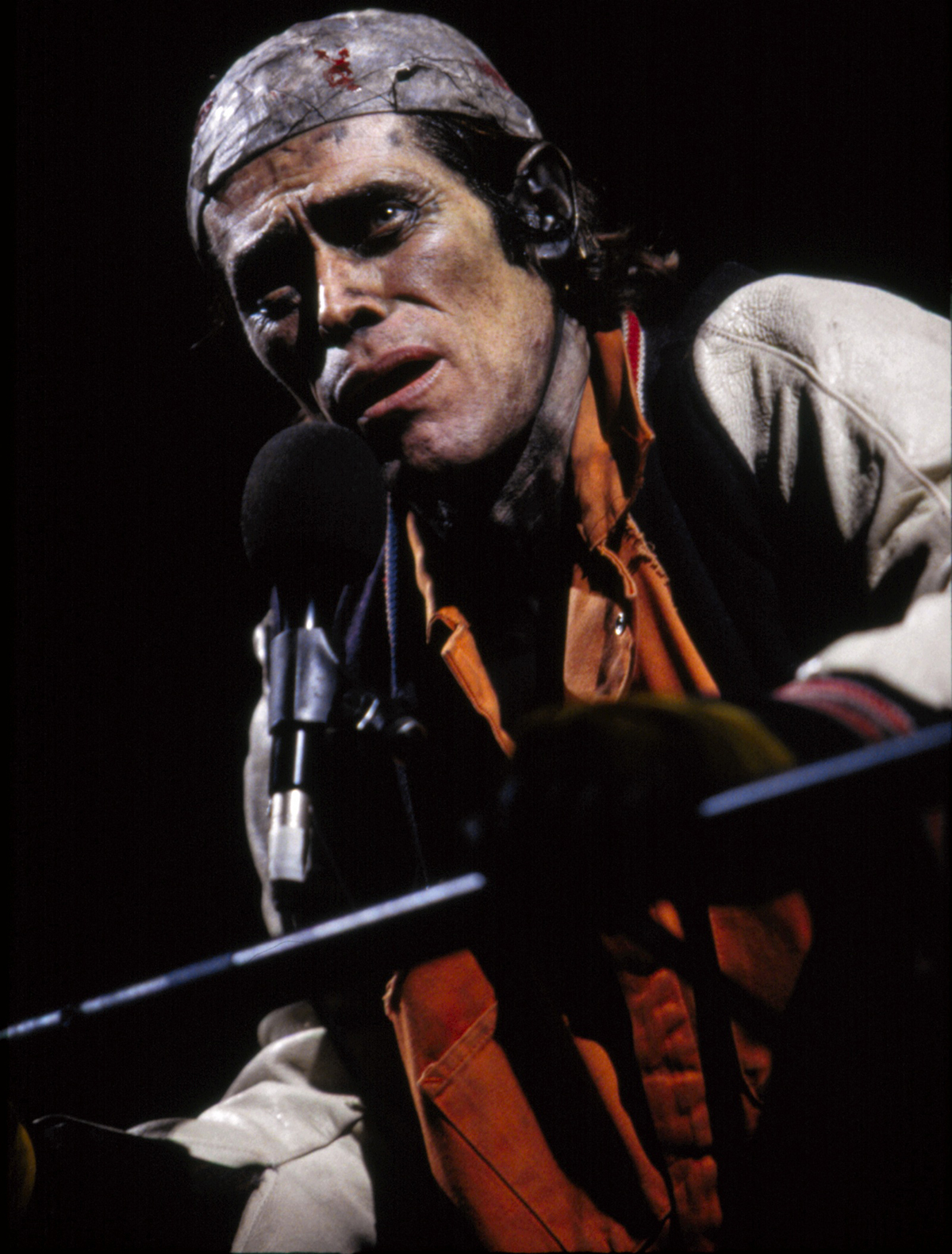
Willem Dafoe, The Hairy Ape, The Wooster Group, (2002), photo courtesy the artists
I wrote about The Wooster Group’s The Hairy Ape (“Terror, Theatre and The Hairy Ape,” February, 2002) five months after the attack on the World Trade Centre. The group’s version of O’Neill’s play highlighted the insurmountable disparity between those who work to keep the wheels of society moving (the ordinary workers), thinking that they therefore move the world, and those who wield the real power invisibly behind doors in board rooms and drawing rooms. I read the production through the lens of a remarkable book by Anthony Kubiak called Stages of Terror. “The book is an attempt,” I wrote, “to write a history of theatre as terror. More than that, it argues that theatre’s ability to name that terror at the base of life has always been one step ahead of the society in which it has played. That the culture of perception which it has engendered in all its forms has, far from mirroring its society, found ways of developing for that society an understanding of the terrifying interplay between power, production, coercion, ideology and identity—an interplay that is based upon the application of terror and its close allies, violence, pain and panic. This may seem to be a bleak reading of theatre and of history itself. I don’t think so. It is bracing to witness with clarity the powers that cloak themselves in all sorts of coercive masks within our society and it is true that theatre above all is the artform that can, that has and that should reveal those masks — even if it does so (as in Restoration comedy) by applying them even more rigidly.” The Hairy Ape revealed the masks cloaking the State terror.
So too did Schauspielhaus’s Stunde Null which I saw at LIFT in 1997. It was among other things a play about a school for politicians, who act like children and are treated as such as they learn the gobbledygook language of politics. “What do politicians really expect us to believe?” I asked. “They lie, they know they lie as they lie, and they must know we know. And the media is complicit in this constant rending of language and meaning. They make the show of attempting to reveal, they push so far but they never never tip the bucket. Someone needs to tip the bucket. Stunde Null does so.” And it did so through laughter, unstoppable laughter. “Politicians have been attacked with laughter and corroded with irony since Aristophanes. Laughter in that form is a revolutionary force. It refuses to accept the world on the terms that the politicians or the daily media present it to us. It turns the world upside down, allows us another way of looking at it.”
And this in the end is my feeling about theatre in a time when politics takes no notice. What all these companies did was to force politics to take notice because they spoke to politics, rejected being a ‘mirror’ for society, refused to turn inward, remained aware that theatre’s blinding vision is a revelatory force. “Just as pain and terror both cause and effect each other,” wrote Kubiak, “so, in its articulation of terror, theatre operates as both cause and resistance to that terror and oppression.”
–
Read about Richard Murphet here.
Top image credit: I Am Blood, Jan Fabre, photo courtesy the artists
I have been working in theatre now for over four decades: as actor, director, playwright and teacher. Theatre in its infinite diversity has provided an ongoing structure to my life, not the only one but a significant one. Doing, viewing and thinking about theatre has deepened my understanding of myself, of others and of the life we lead as social beings. I am totally grateful for it. But I have only written about theatre since 1996 when Keith asked me to interview a British theatre writer, Deborah Levy, then on tour in Australia. As a practising artist, I had always found it impossible to write in judgment of other artists (as the act of reviewing is usually conceived). RealTime offered another way of writing: in open, not necessarily judgmental response to a work or an artist, revealing as much about my own self in the process, and associating out from the work to wider social issues. My final piece for RealTime in 2007 was an obituary for Lindzee Smith, one of the great unsung champions riding the waves of change in theatre/performance that took place in the final decades of the 20th century. Somehow his death seemed the right time to move on. Since then I have completed my PhD on late-modernist theatre practitioners, many of whose peers and successors I witnessed in my years watching for RealTime. I continued reading RealTime until the very regrettable end. I present new works yearly on a blissfully small-scale at the incomparable La Mama Theatre in Melbourne.
Exposé
My trajectory in theatre has been such that I have known I could never survive financially from my projects. I was blessed for a quarter of a century to work at the Victorian College of the Arts, training generations of directors, writers and performance makers. They kept me alive financially and artistically; their constant curiosity and need to speak anew never allowed me to stand still. Art changes: that is its beauty. It is alive to the times. The exciting artists are those who discover how to express that aliveness for this moment now. Writing about theatre needs to take this into account. For each artist, the work that they are making matters, and the energy and time expended deserve their due in our responses. RealTime provided sufficient time to reflect deeply upon a performance and sufficient space to voice those reflections. To be written about in RealTime was to know that the work I produced was taken seriously, and that at the very least the article would reveal to me something I didn’t know about my work. As a writer, I could only hope to do the same for the artist and for the readers into the future. Four out of five stars and a paragraph listing the ‘good’ actors is an insult on all sides. My only constant predilection as a viewer and as a writer has been that the performance (or film, or painting or installation etc) does bring to me a new revelation, however small, about the life I am living, the times I live in, the times I have lived, and/or what lies ahead. Otherwise, what’s the point?
A selection of articles for realtime
Evolving the artist
Fabre and the anxiety of formlessness
Rainer Mora Mathews
Genesi: From the Museum of Sleep
Terror, theatre & The Hairy Ape
One of the hardest things to pull off when performing live experimental music is a dramatic hard stop, so I offer my last piece of writing for RealTime as a long slow fade…
Naive states
When RealTime started in 1994 I was a budding performance artist, passionate about all things corporeal, the performing body in all its fleshiness and transgression. I didn’t take much note of the articles about sound in those early years; however, I felt the same tinge of guilt as others who would feel compelled to confess to Keith and Virginia in theatre foyers, “Thanks for the latest edition. I’m sorry I haven’t read all of it yet!”
Somewhere between 1994 and 2001 I underwent a conversion of sorts, gradually bowing my body out of performance and replacing it with the visceral invisibility of sound. I hadn’t written much for RealTime at this stage, contributing a few pieces to the coverage of 1998 and 2000 Adelaide Festivals where I subbed in an all-hands-on-deck affair. The first piece I wrote in 1998 was about the Australian Art Orchestra’s Into the Fire, which aptly describes my experience. It felt terribly presumptuous to critique Paul Grabowsky and the Sruthi Laya Ensemble, so I opted for description and anecdote, equating cacophony and noise with childlike naughtiness — dear me, I’m sorry. In the early 2000s the experimental electronic music and sound scene was gathering momentum. Caleb Kelly (then caleb.k) had been contributing reviews on events such as the reasonably established yet forever renegade What is Music? festival and some other Sydney gigs and conferences; but as he was actively involved as curator there was scope for a new contributor. I’d always felt like I couldn’t review performance in Sydney because I was too amicably embedded in it. But as I was transitioning from a performance to a sound-based practice, Keith suggested that I might try writing about some of these sound events.
The wonderful thing about RealTime was that it was okay to learn on the job. While not an excuse for ignorance, this position offers an ideal phenomenological opportunity, the experience of being ‘bracketed,’ as they say, from encultured assumptions, dealing with what you are given as it is given. In her 2010 book Listening to Sound and Silence: Towards a Philosophy of Sound Art, Salomé Voegelin suggests that a listening experience is not “a receptive mode but a method of exploration…What I hear is discovered, not received.” This describes my first forays into reviewing the experimental audio scene. I was discovering this practice piece by piece, gig by gig. I’d like to think that this opened up the activities to a wider readership who were invited to stumble with me into this dimly lit but gloriously sonorous world.
Of course, I was not devoid of all assumptions. My review of Static Museum, curated by Garry Bradbury at Artspace in 2001, “Boys, toys and pleasing noise” (RT45), opened with the oft-heard gripe around the lack of performativity of laptoppery — though I stressed that this was not the case with this event, a point I’ve since come to care little about as long as the sound itself performs. I also concluded with a complaint about the absence of female artists, framed by a personal, techno-reactionary position that I was someone with no inclination to explore sound from a ‘scientific’ perspective. While the issue of gender still hasn’t gone away (the reason for starting my online directory of female artists working with sound, Audible Women), I wish I had framed that argument with less arrogance and more nuance about the interplay of aesthetics and technology.
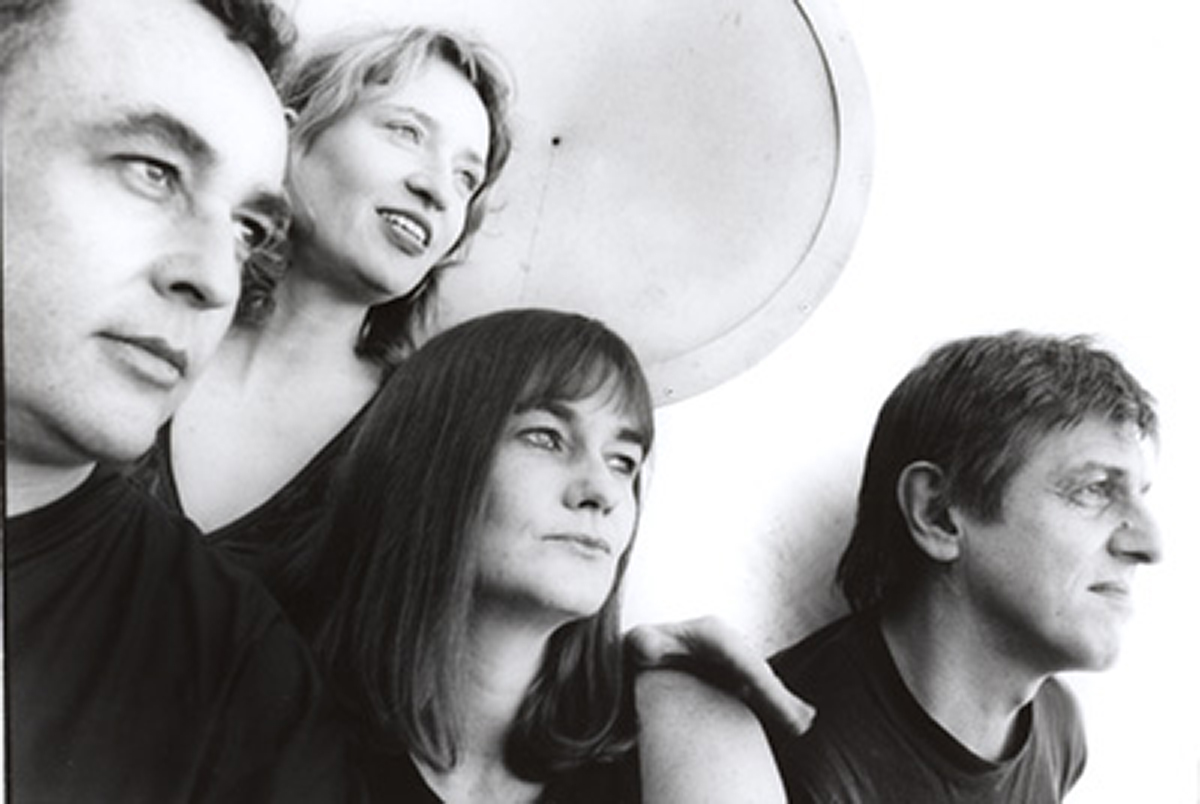
Machine for Making Sense, 2002, photo courtesy the artists
Early epiphanies
As an emerging sound artist with no formal education in this mode, writing for RealTime offered the best education. Beyond my own creative adventures, it allowed me to find my way into sonic art through writing, discovering the pleasures, pains and complexities of experimental audio as it manifested in seminal gigs and events such as the What is Music? festival (RT51), the Machine for Making Sense (you can listen to the Writers Read RealTime version of my review here), Electrofringe (of which I later became a co-director, RT52) and impermanent.audio, curated by Caleb Kelly. My review (RT50) of the latter serves as a kind of turning point in my appreciation of experimental music practice, evidencing when I begin to let go of a performance mindset and start to understand the poetry of sonic processes:
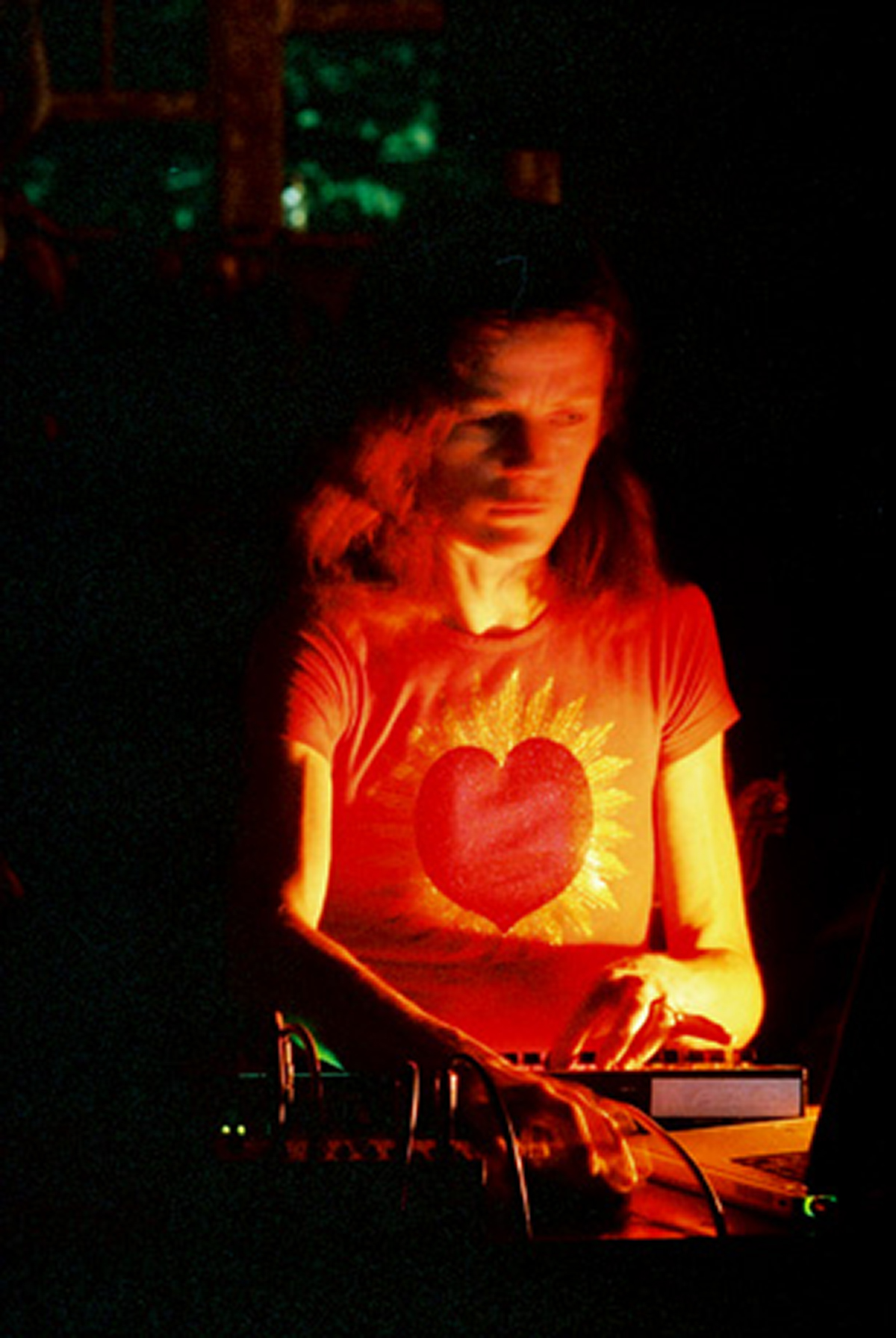
Kaffe Matthews, impermanent.audio, 2002, photo mr snow
“I see the electric transmission beaming out into the ether and [Kaffe] Matthews catching the loops in a digital butterfly net. I get a real sense of the structure of her improvisation — sending the sound out there, and then plucking it back, remolding it, sending it out again. She has a light touch, mixing only a few chosen elements, teasing them out, dropping them. All her butterflies beautifully controlled and musically combined create an intense and rewarding sonic vision.” Like her sound, I too was captured in the butterfly net of sonic possibilities.
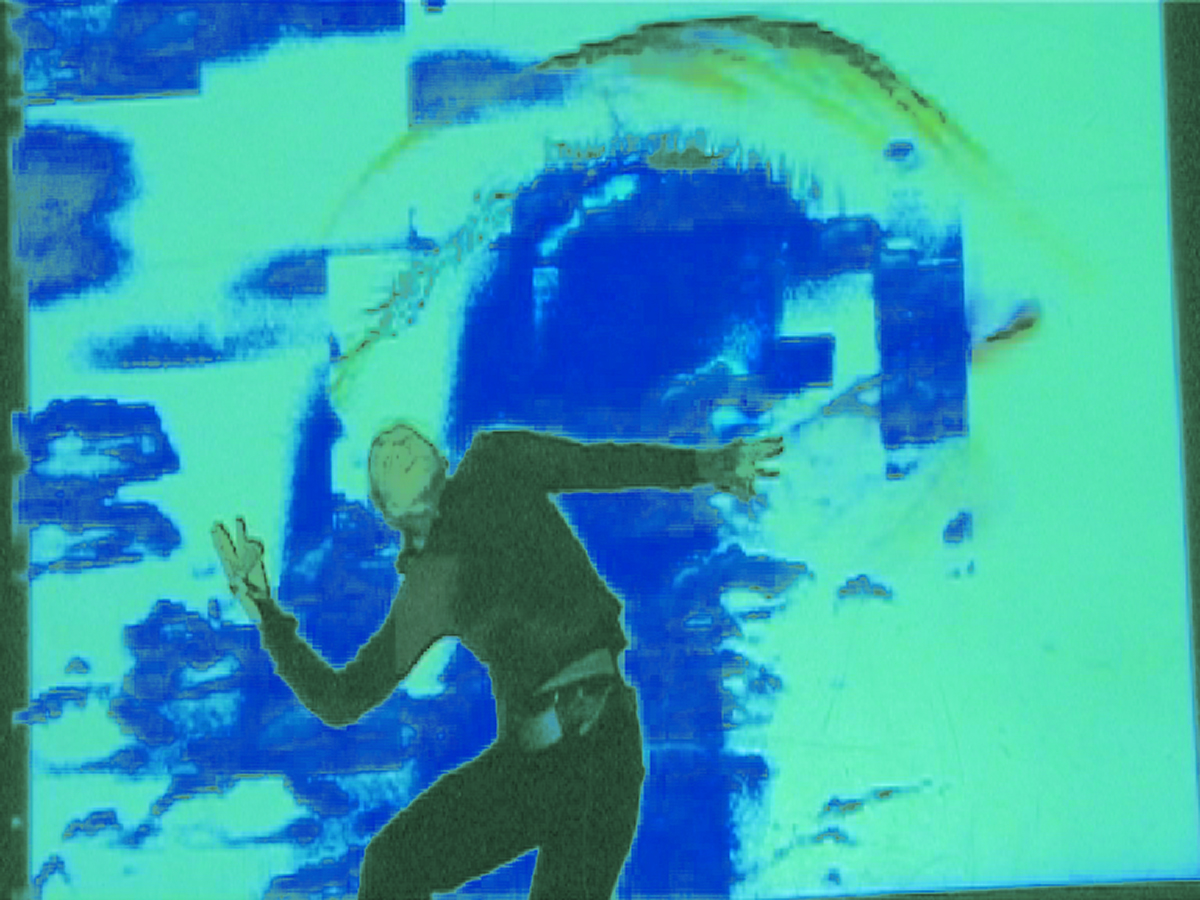
Lindsay Vickery, your sky is filled with billboards of the sky, image courtesy the artist
Networked learning
Of course, it wasn’t just Sydney that was developing a vibrant scene and the opportunity to attend interstate festivals and do larger overviews allowed me, and hopefully RealTime readers, a sense of the activities and the artists practising around Australia. A piece commissioned for New Media Scan (RT51) provided one of the most challenging writing experiences, requiring me to quickly come up to speed with the rapidly shifting technological developments influencing sonic art practices. The article features an overview of Ros Bandt’s excellent book Sound Sculpture (1999) as well as works by Nigel Helyer, Joyce Hinterding, Camilla Hannan and Phillip Samartzis; sound and screen intersections in the works of Andrée Greenwell, Lindsay Vickery, Tesseract Research Laboratories and Wade Marynowsky; pure audio events such as impermanent.audio, Small Black Box and fabrique in Brisbane; and the individual practices of artists Jasmine Guffond, Greg Jenkins, Garry Bradbury and Julian Knowles. It concludes with discussion of new modes of distribution, featuring excited millennial talk about the potential of DVDs to distribute 5.1 surround sound and the new possibilities of MP3 downloads. Having always said that my strength as a writer is in description, rather than argument I was surprised to see that I made an attempt at the latter, quoting Heidegger no less:
“When I commenced the research for this article, I unwittingly set up a determinism/voluntarism polarity which, as with most dichotomies, has proven itself too inflexible to be of value. The reality is that people will continue to hunt for their sonic substances in the areas that are available to them, some old, some new. Perhaps it is best to approach new media with Heidegger’s view of technology — “not as a tool or machine, but rather a process, a dynamic of ‘revealing’.” The older media supply the foundations for the new and the new creates perceptual shifts and ways of reconfiguring the old. And the loop goes on…”
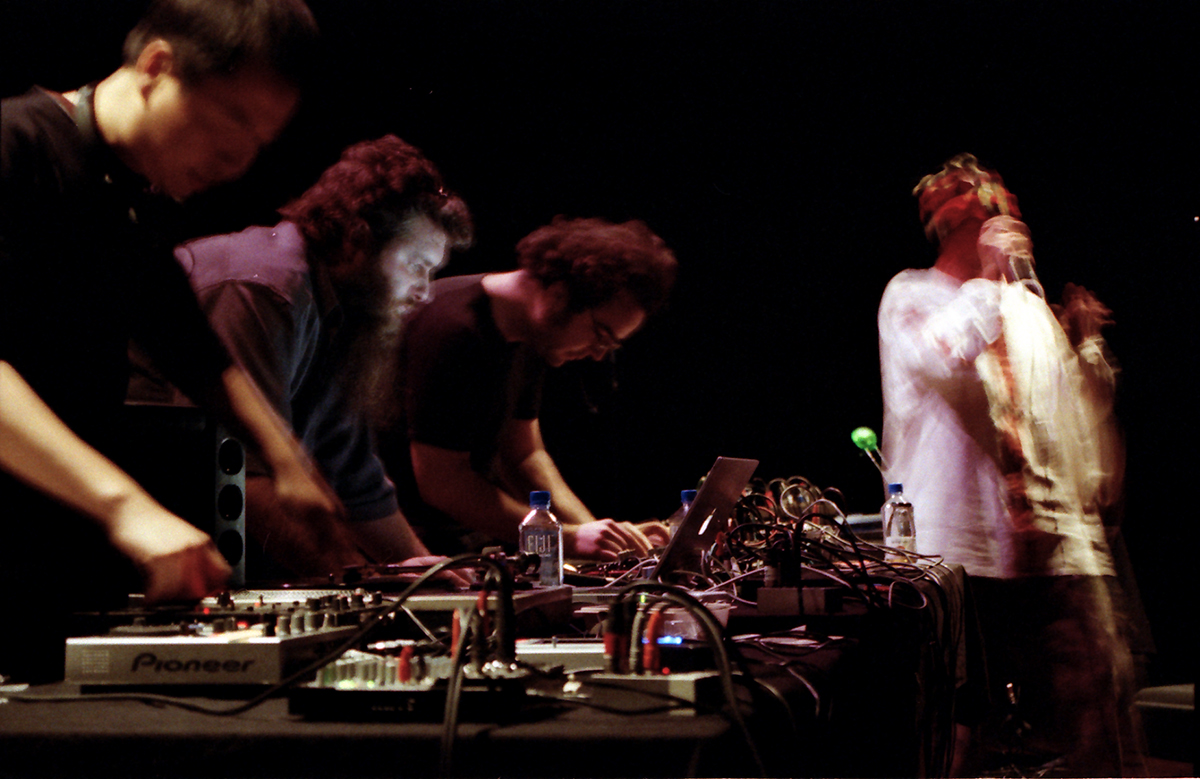
Beta Erko, Liquid Architecture 6, 2005, photo courtesy the artist
Over the next 15 years I voraciously consumed local events and national festivals, the following offering a small selection of personal highlights: my first experience of the NOW now festival in 2003 (RT53); sampling Liquid Architecture 2005 in both Sydney and Melbourne (RT68); the epic REV festival at the Brisbane Powerhouse (RT online); Meredith Monk at Queensland Biennial Festival of Music (RT58); Merzbow and Oren Ambarchi in The Aurora Festival in Western Sydney (RT109); the genre collisions of MONA FOMA 2014 in Hobart (RT119); and experiencing Christina Kubisch’s work, among other sonic wonders, at both Transmediale 2005, Germany (RT60) and Ars Electronica 2010, Austria (RT100).
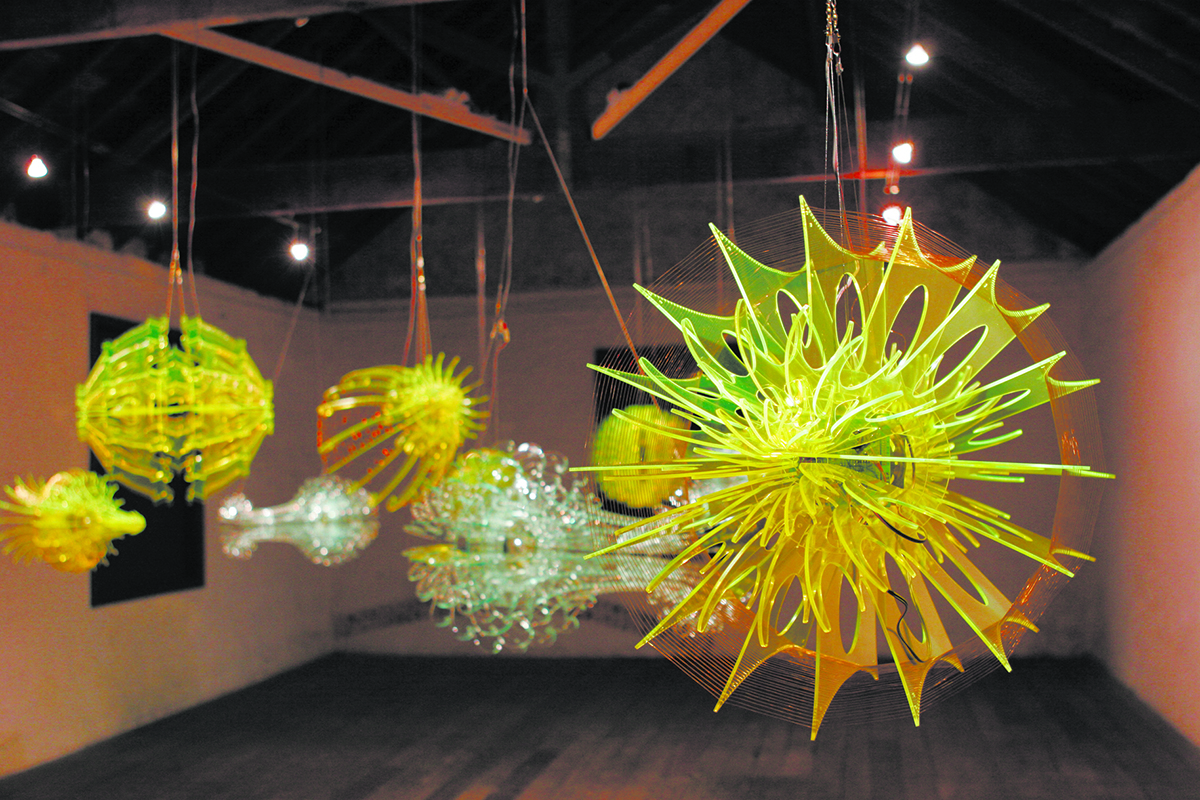
Quint de Loupe, Nigel Helyer, photo courtesy Totally Huge New Music Festival
If I had to pick a favourite article I’d nominate my coverage of Tura’s 2005 Totally Huge New Music Festival in Perth, titled “Totally Huge: knots and flames” (RT70). I used William Blake’s poem The Tyger as an extended literary reference with which to draw together the ambitious sound art exhibition, You are here…entangle (curated by Kylie Ligertwood, featuring works by Nigel Helyer, Cat Hope, Kieran Stewart, Alan Lamb, Rob Muir and Hannah Clemen at the highly atmospheric Moores’ Building, Fremantle) with the ritual catharsis of Annea Lockwood’s Burning Piano:
“Annea Lockwood (NZ/UK), renowned for her ‘piano transplants’…provided a very public face for the festival by installing a baby grand on Bathers Beach in Fremantle. The piano in fact went missing, only to be found a few days later at a local backpackers where they were trying to repair it! Lockwood also provided the highlight of the festival, recreating her Burning Piano performance. Despite the chattering crowd gathered in a paddock ready for a bonfire it was a beautiful meditative event, as the tongues of flame burning rainbow colours penetrated the instrument, skittering across the keys faster than fingers have ever managed, eating away at the backboard so that we could see through the body, until the unavoidable total collapse. A worthwhile sacrifice for art.”
From the horse’s mouth
As well as reviewing, or offering commentary as I prefer to say, there was also the joy and terror of interviewing artists. ‘Terror’ because I was always intimidated by the prospect that my lack of formative sound art education would make a fool of me. However getting directly acquainted with artists’ ideas made the terror more than worthwhile, and it was an honour to be able to commune with great minds, many through interviews including some for RealTime TV; to name a few: Robin Fox, Cat Hope, Lawrence English, Marina Rosenfeld, Pia van Gelder, Kusum Normoyle, Ben Frost, Michaela Davies, Matt Warren, Garth Paine, Eugene Eughetti, Sarah Last and more.
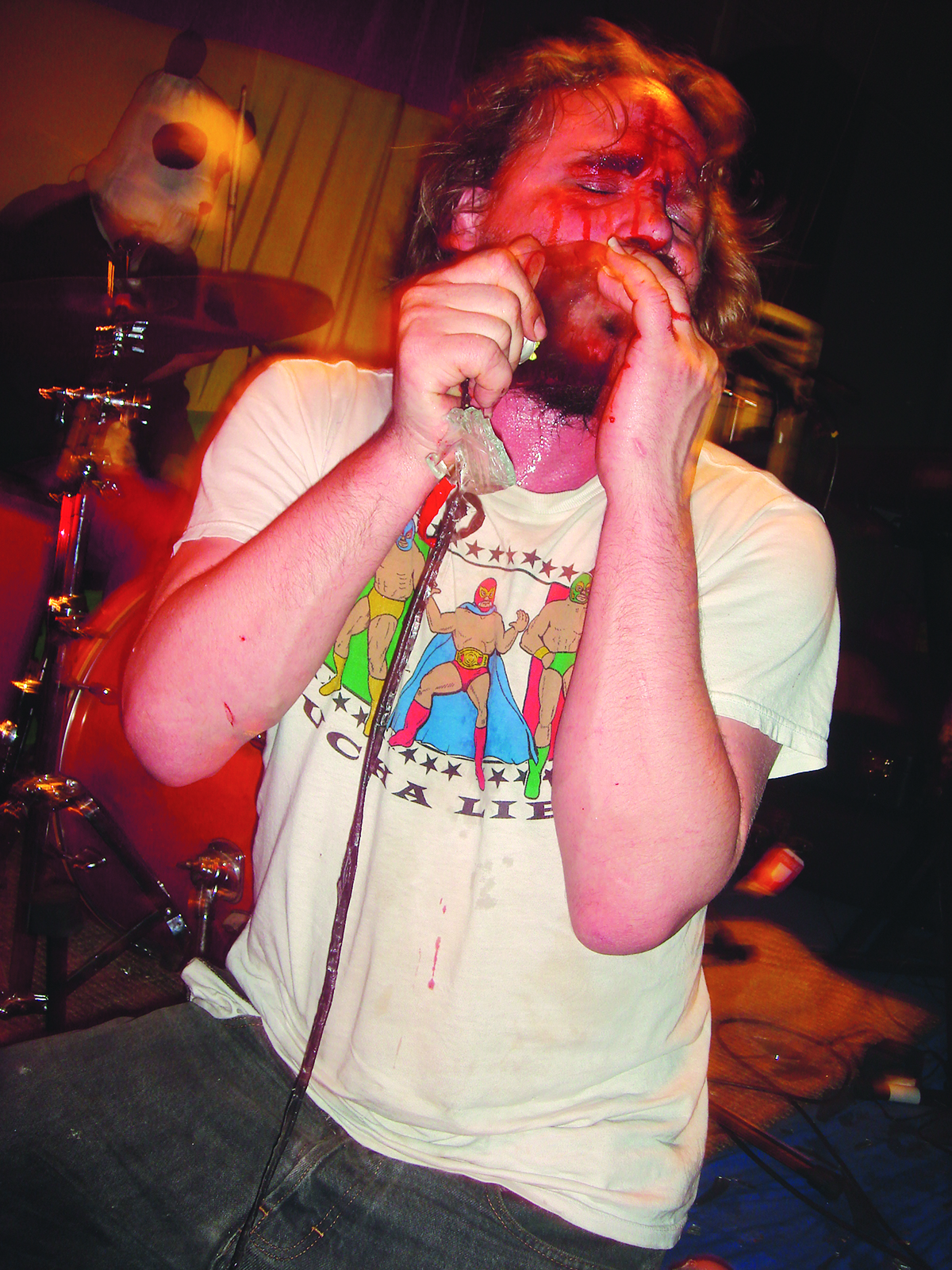
Lucas Abela, Rice Corpse, tour of China, November 2008, photo courtesy the artist
A notable interview highlight (RT92) was a co-authored affair with former RealTime Assistant Editor Dan Edwards, then our ‘man in China,’ who interviewed improvising musicians Yang Yang and Li Zenghui in Beijing, while I interviewed broken-glass noise virtuoso Lucas Abela in Sydney, about the three artists’ collaborative outfit Rice Corps. The article’s title was particularly special, “that was shit!,” reflecting the literal translation of the Chinese character for the band name doubling as shit. However I could pretty much hang up my interviewer hat and die happy after I was given the opportunity to talk to my all-time inspiration, Laurie Anderson, in the lead up to her appearances at the 2013 Adelaide Festival. To this day, I have never been as nervous as I was dialling her phone number. I thought I would have trouble trying not to babble hysterically over the top of her measured and thoughtful responses describing her upcoming collaboration with the Kronos Quartet; but in fact I found myself uttering few words, so read Ms Anderson’s (I was also obsessed as to whether or not I could possibly call her Laurie) in RT 112.
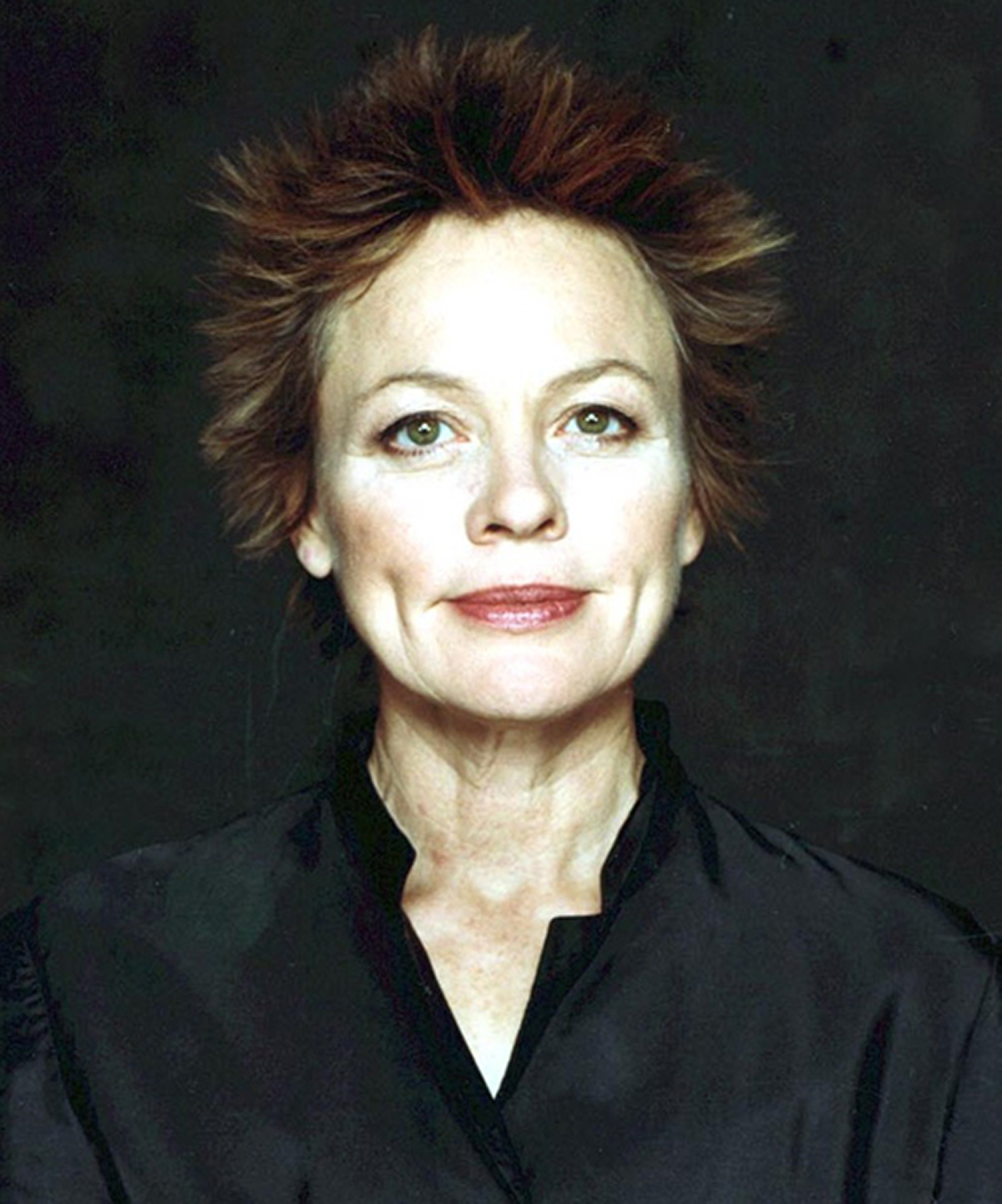
Laurie Anderson, photo courtesy the artist
The past before my past
While dwelling mostly on the distant past of my writing for RealTime, it’s important to acknowledge that there was a past before this. Leading up to the recent RealTime in real time event at Performance Space’s Liveworks, I read many of the sound articles from those early editions, those ones I passed over at the time. Articles, such as Tony MacGregor’s account of Sound Culture Japan ’93 and Australian Sound Art Meridian Kobe (1993) (RT1, p20) and Annemarie Jonson’s 1994 preview of Sydney’s Sound Studio — curated by Alessio Cavallaro at Performance Space — and Melbourne’s Earwitness (RT 3) — curated by Sonia Leber as part of Modern Image Makers Collective/Contemporary Music Events Company (later to become Experimenta) — reveal a thriving sound culture with exhibitions and events of scale such as the ambitious and contentious Sounds in Space (RT8, p13) at the MCA curated by the late Rebecca Coyle (1995).
Sound installation and sculpture were the predominant forms discussed, along with what was then a thriving radiophonic culture centred on ABC programs Surface Tension, The Listening Room and Radio Eye, driven by producers and creators such as Tony MacGregor, Kay Mortley, Virginia Madsen, Roz Cheney, Jane Ulman, Brent Clough, Sherre DeLys, Sophea Lerner and RT’s own Keith and Virginia. There was also the Contemporary Sound Arts group lead by Alessio Cavallaro, Shaun Davies and Annemarie Jonson publishing the Essays in Sound series — Cavallaro and Jonson not soon after taking on the mantle of editors for RealTime’s OnScreen section. While there is some mention of more experimental electronic music practice with Machine for Making Sense and Jon Rose appearing quite frequently, it is the live performance of sonic art (appearing as something not quite like new music/contemporary classical) that seems to come more to the fore in editions from the late 1990s/early 2000s, the era in which I enter.
Sonic art in three movements
Across the pages of RealTime, I see sonic art having three, not distinct, but certainly recognisable phases. The first until around 1999, summarised above, is focused on sound within gallery culture, radio art and emerging collaborations with screen media. In this way it was engaged with institutions and organisations. The second stage is from around 1999 when the live sector strengthens, made possible by the development of more portable equipment and digital audio accessibility. With roots in post-punk art rock it is a decidedly DIY scene, taking place in illegal warehouse venues and inappropriately reverberant artist-run spaces, occasionally making guest appearances in the institutions that had previously housed the aforementioned mid-1990s sound art events. That said, What is Music? made incursions into the Sydney Opera House in 2002 while still keeping it real with concerts in underground venues (see above) — that’s how curators Oren Ambarchi and Robbie Avenaim roll. Interestingly this was also the heyday of ‘new media art;’ many sound-oriented installations and interactive works actually moved over to be considered within this context (see the sound section of RT’s Media Art Archive).
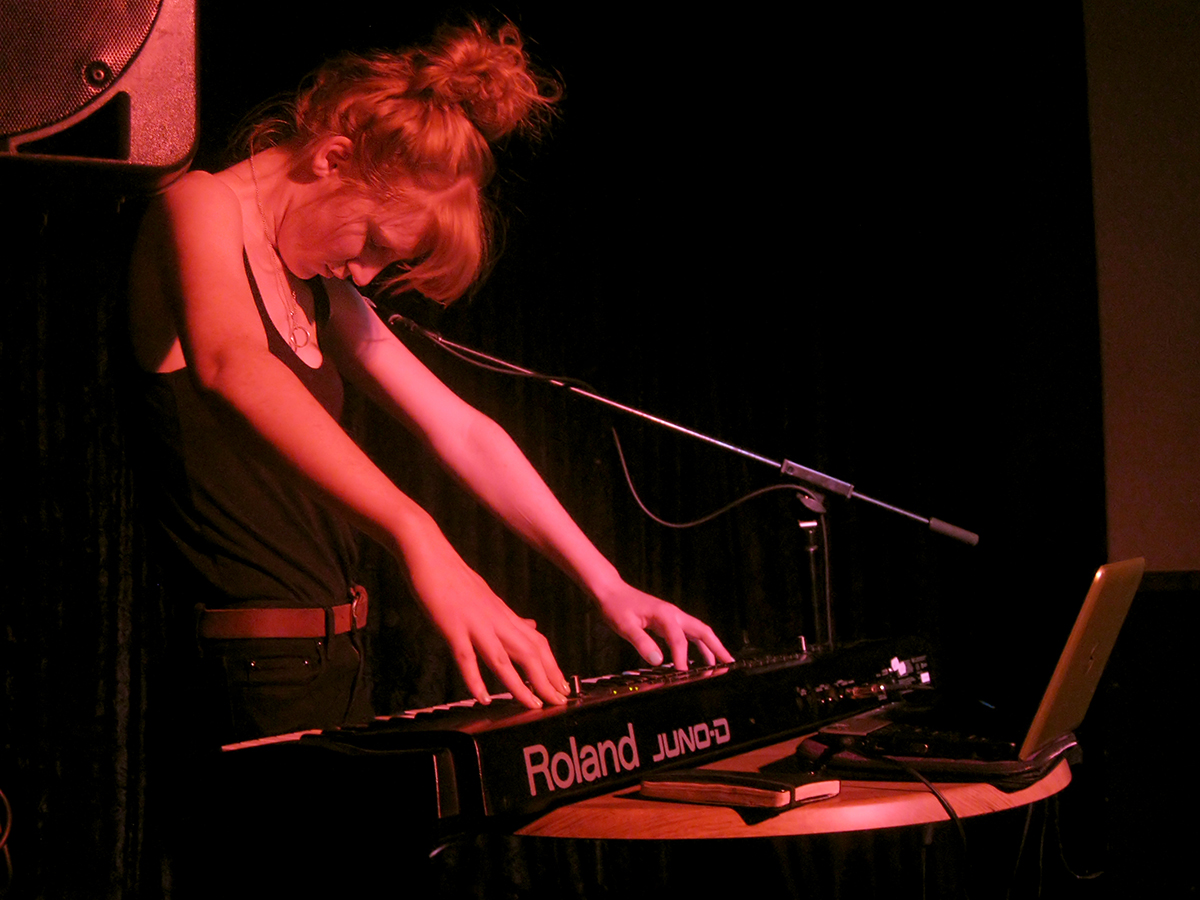
Daisy Buchanan, Ladyz in Noyze, photo courtesy the artist
Within this live scene there have been ongoing waves of activity, the occasional lull making us nostalgic for the early 2000s. From the Sydney perspective alone, as late as 2011 there were enough events for a three-part overview series (RT103, RT104, RT105), admittedly some on their last legs. But today (Nov 20, 2018) I noticed that Sydney offers at least one event a night this week, if not two, for those interested in the pointy end of experimental practice.
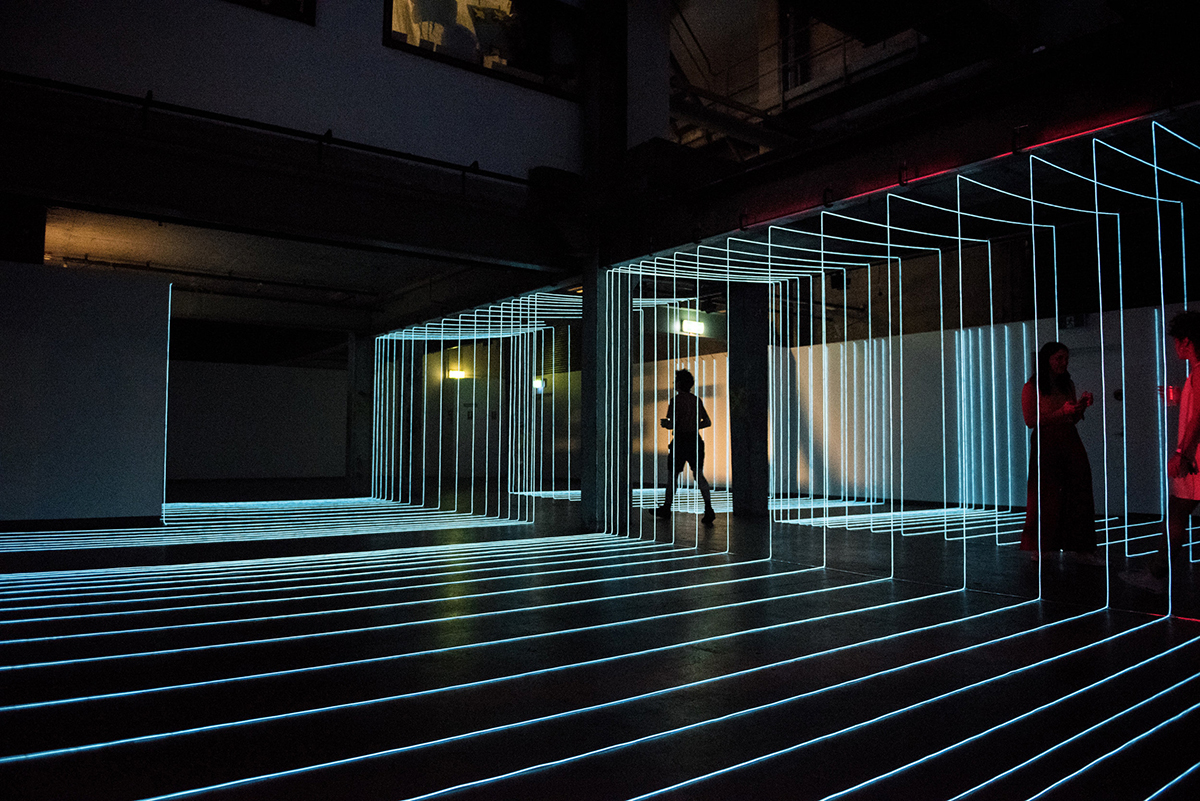
Meagan Streader installation for Soft Centre, Casula Powerhouse Theatre, photo courtesy the artist
We are now in what I suggest is a third phase, one in which the boundaries between new music/contemporary classical and the experimental electronic scene have blurred. This has long been the case in Perth for example, where a smaller population and genre-fluid artists like Cat Hope ensured a certain kind of slippage. In Sydney it has occurred as younger electronic music-literate artists have emerged from more traditional music schools, not just from art schools, and contemporary music ensembles such as Ensemble Offspring have actively pursued all manner of collaborations and genre experiments. Perhaps it has also occurred as funding sources have become scarcer and the new music scene has started to adopt a more DIY approach. However it has come about, the live experimental music scene has continued to grow, and even spread to outer suburbs with programs at Western Sydney Arts centres like those in Campbelltown, Blacktown, Bankstown and the latest ambitious adventures at Casula Powerhouse with the Soft Centre festival (18, Oct 2017).
All this is to say that RealTime’s coverage, above and beyond my contribution, offers an inevitably incomplete, yet amazingly varied account of sonic art which, although I have focused on the live side here, also encompasses gallery-based sound art and media art. (For a rousing definitional debate see Nigel Helyer’s provocation in RT70 and Ben Byrne’s response in RT72). It is hard to imagine how we will be able to get a sense of upcoming developments without RealTime, an incredible source of documentation and commentary. There will be blogs (or is that already over too?), there will be Tweets and Facebook rants (if people can take time out from signing petitions for every other horrible thing going on in the world), but we will keenly feel the loss of that special space where not just the sonic arts, but all the innovative arts in Australia could be reflected on in depth and, equally importantly, be celebrated.
–
Top image credit: Merzbow performs at Riverside Theatres, Parramatta, Aurora Festival of Living Music, 2012, photo Matthew McGuigan
When it was announced in December 2017 that RealTime was drawing to a close, we received hundreds of heartfelt messages expressing gratitude for the magazine’s unique coverage of innovative art and sorrow at its passing.
We’ve gathered together those messages in a single document which will become part of the RealTime archive.
You can read the tributes collected in December 2017 here.
–
Top image credit: Keith Gallasch, Virginia Baxter, masks made from pages from RealTime by Beatrice Chew, photo Su-An Ng, art direction Graeme Smith
In 2009, my interview for RealTime with Bangarra Dance Theatre Artistic Director Stephen Page ended thus, when he asked, “I don’t know why there are no sister dance companies for Bangarra across the country; why no Bangarra theatre, no Bangarra music? Why am I one of so few who are fortunate enough to be able to create in my own cave, with a stream of youngsters wanting to tell their own stories to me, now that I’m the elder?”
And those are still excellent questions today. For, with less than 3% of Australia Council funding going to Indigenous arts, Bangarra Dance Theatre is still the only dance company recipient of ongoing Major Organisation funding from the Australia Council. Somehow, eight other Indigenous dance companies exist on project grants and individual funding. But this is a situation which BlakDance — self-described as, “We’re a national organisation that provides managing and producing artist and presenter services and sector advocacy … prioritising independent artists and emerging small to medium companies” — is determined to change.
“We’re aiming for a deep dive into the future,” declares Merindah Donnelly, Executive Producer of the Brisbane-based BlakDance. “In the light of questions raised by the Australian Major Performing Arts Group (AMPAG) Review, we’re advocating the states and territories and the Federal Arts Minister consider funding any of the eight or more small to medium emerging Indigenous dance companies”.
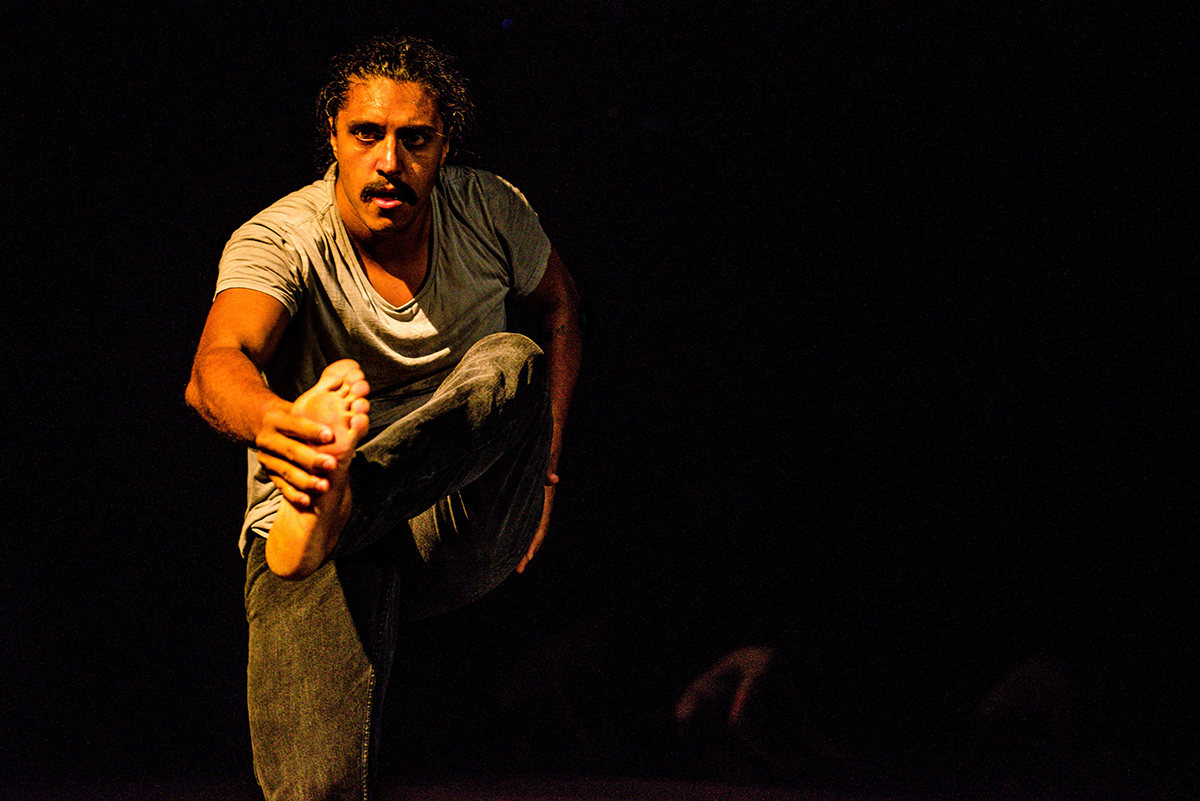
Thomas E.S. Kelly, Misconceive, image by Simon Woods
Not being national dance companies — apart, arguably, from the dynamic Marrugeku, which is defined as intercultural rather than Indigenous — few are aware of these riches. There are many emerging groups, collectives and companies; the eight who have given permission to be mentioned are: NT Dance under Gary Lang, Karul Projects in Queensland led by Thomas ES Kelly, Ochre Dance in WA, Artistic Director Mark Howett, Queensland’s Pryce Centre For Culture and Arts, Executive Director Rita Pryce, Cairns’ Miriki Performing Arts Company, Wagana Aboriginal Dance Company in Sydney, and, both Brisbane-based, Digi Youth Arts and a new and emerging First Nations physical theatre collective currently under the stewardship of Casus Circus.
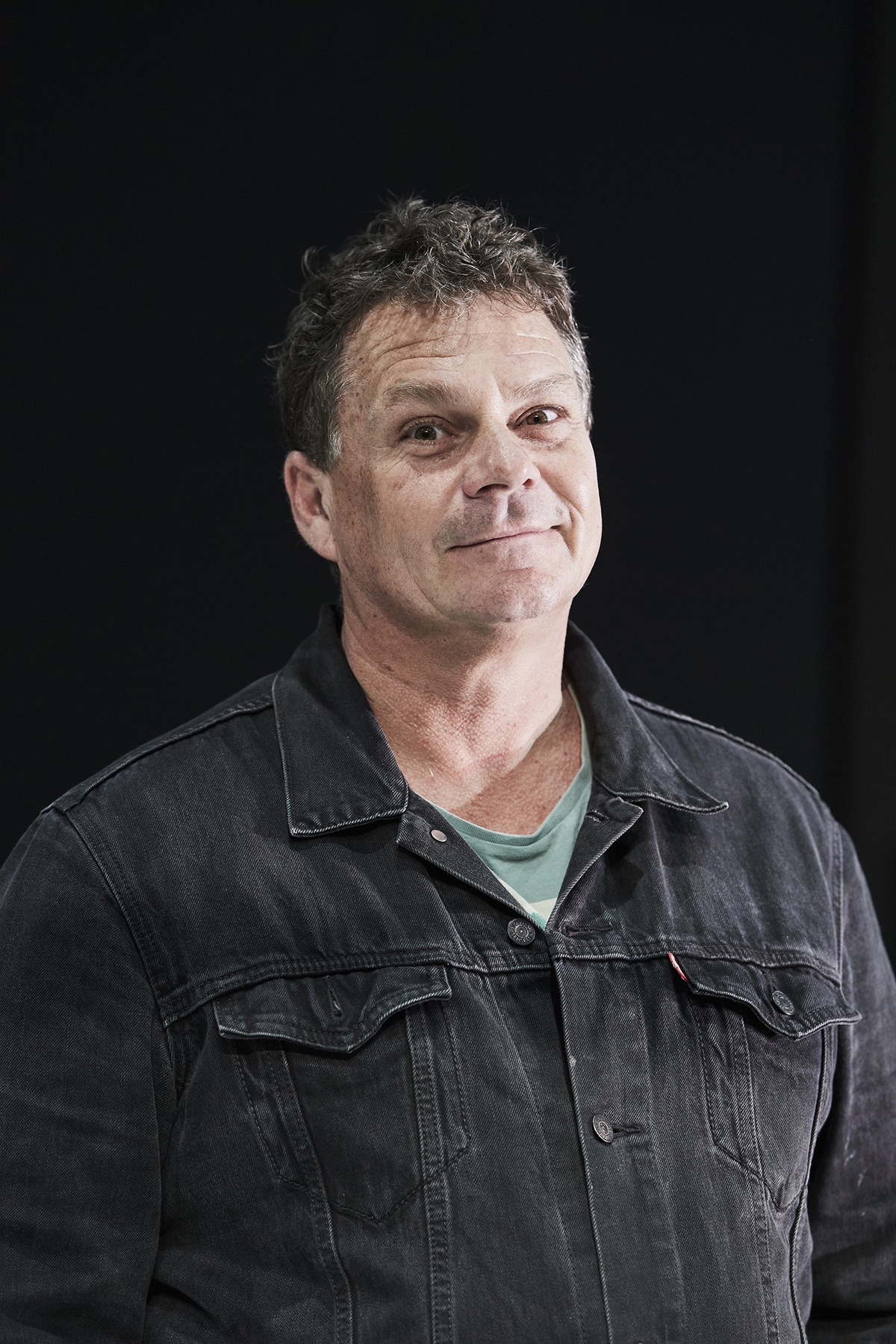
Mark Howett, photo courtesy the artist
Individual artists who’ve been involved in mentoring, training and choreographing for these companies include Vicki Van Hout, Joshua Pether, Katina Olsen, Ghenoa Gela, Amrita Hepi. Joel Bray, Mariaa Randall, Jacob Boehme and Carly Sheppard. Most are better known than the companies — and it’s an anomaly that someone like Van Hout — who’s been around the dance traps since performing with the Aboriginal Islander Dance Theatre (AIDT) in 1989 — hasn’t formed a permanent company.
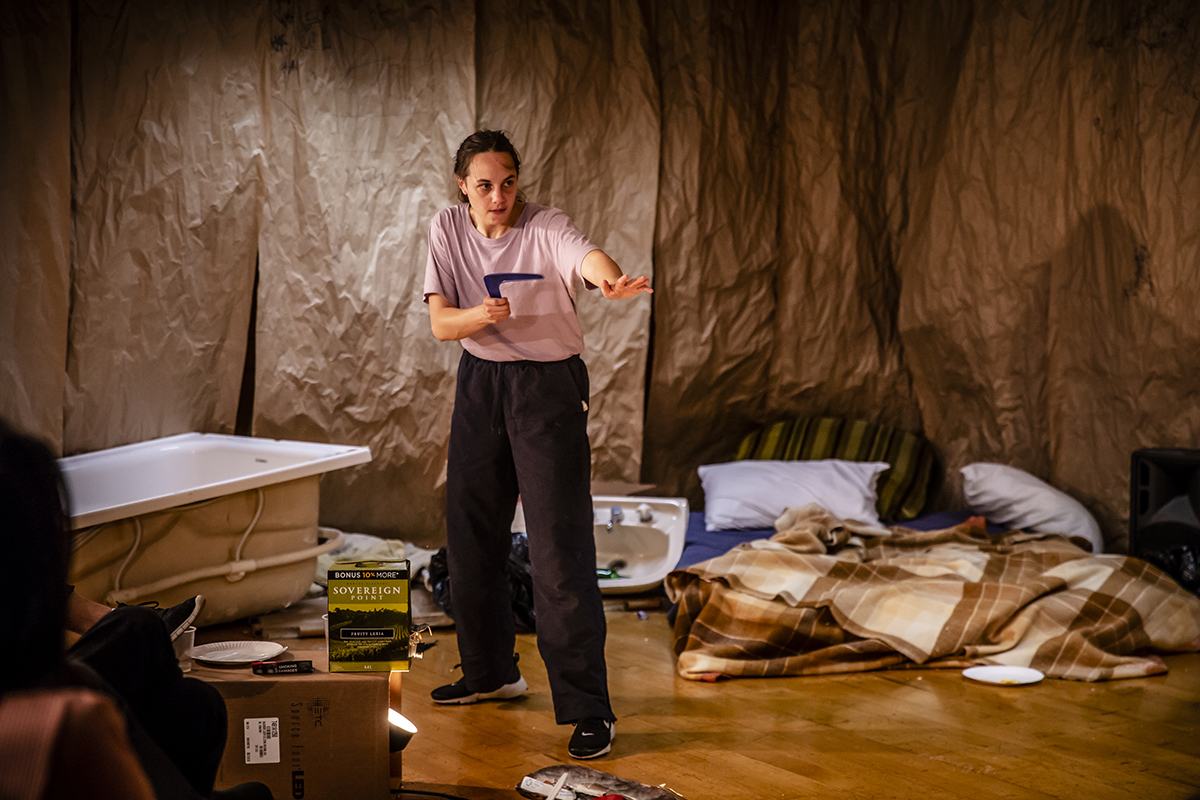
Carly Sheppard in Crackers n Dip With Chase n Toey, image by Bryony Jackson
Could BlakDance, founded by Marilyn Miller in 2005, have facilitated that? It has led a five-year project which will see many of those individual dancers performing in New York in January during the 2019 First Nations Dialogue which will give the Big Apple more First Nations art than it’s ever seen. “It’s been 40 years in the making,” suggested Donnelley. “Uncle Bob Maza went there all those years and met with Spiderwoman Theatre — the Native American company named for a Hopi goddess.”
A key linkage here is Emily Johnson, a Yup’ik woman from Alaska who runs the longstanding Catalyst company offering “body-based work.” When Catalyst was programmed for festivals in Australia she learnt about our Indigenous scene. What emerges from the [Catalyst] website is that her collaborators are principally but not exclusively Indigenous, and her work is firmly based in her culture. Is this a model for Australia’s young Indigenous dancemakers?
What I gleaned from my conversation with Merindah Donnelly was the sense that the current, scrambling generation has clearly moved on from the models created by the Aboriginal and Islander Dance Theatre (AIDT, 1976-1998) and Bangarra whose leaders believed in the essence of traditional or classical Aboriginal and Torres Strait Islander cultures from the remote north as the root from which their work should grow. Stephen Page may have complained a decade ago about the effort required to conform to ancient protocols, but he shows no sign of throwing out that baby even today.
This week, Bangarra’s Dubboo at Carriageworks pays tribute to the personality of Page’s late brother David and to the 27 scores he wrote for the company, “licensed,” as Page said recently on the ABC, “by Djakapurra (Munyurryun) to fuse traditional and contemporary music.” Djakapurra’s earth-shaking Yolngu chants have grounded many a Bangarra score. And his dancing and choreography appeared as recently as 2016 in One’s Country, featuring Arnhem Land, TSI and urban responses to the land beneath the dancers’ feet. While historical works like Dark Emu, Bennelong, Patyegarang and Macq seem to have predominated of late, Bangarra hasn’t ignored the Indigenous present in Blak, Belong and the feature film Spear.
It’s a broad church that satisfies the AMPAG agenda and makes it easy for the federal government’s Department of Foreign Affairs and Trade (DFAT) to present Bangarra around the world as artistically exciting and a valid representation of Indigenous culture in Australia.
“But has Bangarra made it challenging for the small to medium First Nation dance sector and independents to come through,” asks Donnelley at BlakDance. “Because of racist stereotypes there can be an expectation that all our work needs to be recognisably Indigenous; and most are a mile away. Our independents are not offering large-scale mainstage productions, they’re experimental and multidisciplinary. A dance may contain the same values and process as a female ceremony. Is it more Indigenous than a potentially out-of-context cultural/traditional performance of dance?”
Who would know, I wonder? Tribal dance is so rarely seen in the cities of the south; though you could have found some at the Sydney Opera House’s recent Dance Rites, just over for this year. Donnelly continues: “I do think the younger generation have more freedom to work with whoever they want, however they want — thanks to the trailblazers”. And here she wants to make it clear: “I don’t want to come across as a Bangarra naysayer. As someone who trained in ballet I considered joining them and I love and respect Stephen. The size and scale of the Indigenous dance sector today is not unrelated to Bangarra showing young people themselves as dancers on stage and no one can underestimate the impact Bangarra has had on hundreds of thousands of audience members over time. The company is significant and should be upheld as such.”
But Donnelly has to argue that what might well be the largest Indigenous dance sector in the world is unfairly dominated by one company when it comes to funding, which determines the curatorial practices of presenters. And in terms of training, “We’ve got NAISDA Dance College (Gosford, NSW) and ACPA (Brisbane) — the two dedicated Indigenous training schools for performing artists — pumping out 30 graduates a year; where do they go? Bangarra might take two! Why train unemployable dancers?”
It’s contestable that there was ever an intention to have two complementary training schools for Indigenous artists. When Paul Keating brought down his Creative Nation cultural policy in 1994, he made it clear that he’d deserted the classical cultures of the north for urban Indigeneity and NAISDA was intended to move to Brisbane to match NIDA as a national centre for Indigenous performance training. Somehow NAISDA refused to bow. Its emotional hold on the industry was too great.
Fortunately, Bangarra has managed to contextualise tribal dance in its work in a way that doesn’t happen in the visual arts. There, an uncrossable divide exists between Western trained Aboriginal artists in the cities and the ‘untrained’ artists of the north who just have to make do on 40,000 years of visual mnemonics to tell their stories. Yet the politics of the situation insist they’re both ‘Aboriginal art.’
In my writing, I identify the urban work as Blak art, and therefore see sense in BlakDance’s separation argument. Of course, tribal dance and ceremony were defunded in the 90s, forcing Nugget Coombs’ Aboriginal Cultural Foundation to close down and the great inter-tribal dance festivals on Groote Eylandt were no more. Arguably, this was contributory to the troubles that incited the Intervention! But, coincidentally, both Stephen Page in his 2009 interview and BlakDance’s report of its 2017 National Indigenous Dance Forum seem to agree on a concept that wouldn’t be out-of-tune with the ACF’s raison d’etre, “The purpose of dance is not just about art — it’s also about culture as medicine.”
–
Jeremy Eccles is an arts journalist, theatre, opera and dance critic, writing for RealTime from 2000. In later life, he’s specialised in Indigenous arts and cultural commentary in art magazines, newspapers and online as editor of Aboriginal Art Directory.
As Bangarra presents Dubboo — Life of a Songman, a tribute to the late David Page this week in Sydney, we return to Jeremy Eccles’ 2009 interview with brother Stephen Page who delivers frank observations about sustaining culture, dealing with protocol challenges, skin politics and his role as elder. Read the interview here.
Dubboo — Life of a Songman plays this week, 6-8 December at Carriageworks.
–
Top image credit: Stephen Page, photo courtesy Bangarra Dance Theatre
Featuring eight new Australian works speculating on how we might commemorate the climate change era, Climate Century is the culmination of a five-year process undertaken by Port Adelaide-based experimental art organisation Vitalstatistix. The three-week festival, comprising talks and workshops in addition to the main program’s suite of performances and installations, comes at a darkly propitious moment. Last month’s Intergovernmental Panel on Climate Change (IPCC) report warned we have only 12 years in which to cap global temperature rise at 1.5C, while last week over Thanksgiving the denialist Trump administration buried its own study — forecasting worsening and more frequent natural disasters and existential risks to human health and the economy. As I write these words in late November, Sydney is experiencing a ‘once-in-a-lifetime’ storm while, in Queensland, a similarly unprecedented spate of ‘catastrophic’ bushfires rages across the state.
In the absence of cogent policy to avert such cataclysmic developments it’s possible, and perhaps even necessary, to take heart in initiatives like Climate Century and its inventive explorations of climate grief and memorialisation through frameworks — speculative, post-colonial, queer, and body-centred — pushing beyond, in the words of Vitalstatistix Artistic Director Emma Webb, “small-l liberal climate change messaging.” With multiple performances cancelled and rescheduled due to erratic weather, the festival took on an eerily fitting atmosphere of disruption and uncertainty. Its concluding event, Unbound Collective’s Sovereign Acts III: REFUSE, relocated from an outdoor location to Hart’s Mill Flour Shed, proved an affecting, ritualistic finale. Blending poetic and political song, spoken word and traditional ceremony, and drawing together the physical and spiritual traumas of climate change and British nuclear testing in a quietly powerful repudiation of colonial brutality, the work returned us, all too briefly, to a “time before concrete waters and polluting visions.”
Pony Express, Raft of the Medusa
Of Raft of the Medusa’s first iteration, performed as part of Vitalstatistix’s annual artist hothouse Adhocracy in 2016, I wrote on my blog: “Intended by its creative team of Ian Sinclair and Loren Kronemyer to finally be performed on a life raft, the blackly humorous work is a commentary on rising sea levels, the titular watercraft — inspired by Théodore Géricault’s infamous depiction of the wreck of the French naval frigate Méduse — pitted against a dilapidated yacht in a ‘mid-apocalyptic’ contest.” The yacht, as it turns out, is the Archie Badenoch, an ex-naval cruise boat more used to hosting school groups than participatory performance art audiences.
From the boat’s cramped cabin we witness Sinclair and Kronemyer adrift on a canoe, the performers swathed in thermal blankets as though anticipating rescue rather than any on-water skirmish. Has the Port, apparently second only to Bangladesh in terms of its vulnerability to climate change-induced sea level rise, flooded? Are these the only survivors? Eventually we draw up alongside them and they clamber aboard, dressed only in their underwear. I immediately note the red welts that cover their bodies, the source of which remains obscure — some kind of squid? — until Sinclair prostrates himself on the cabin floor and Kronemyer begins to apply suction cups to various parts of his body, a ritual evoking both the camp and the uncanny. They begin a conversation about failed relationships and use our suggestions to create a list, later transposed to Spotify, of good breakup songs (Cher, that ageless queer icon, features heavily). We fill a notebook with (un)romantic clichés: “it’s not you, it’s me; I need to find myself; this is goodbye forever.” Champagne is passed around to toast new beginnings, and I wonder if this is what I have inadvertently signed up for — a ceremonial uncoupling from the anthropocentric past as we have known it.
As our playlist reverberates around the cabin, Sinclair and Kronemyer return to their canoe, instructing audience members to empty a crate of potato chips onto them. As they drift away in the late afternoon sun, seagulls swarm, an enormous flock taking off from a nearby hill in a strangely beautiful image of human-animal cohabitation, a sign, perhaps, of the shape of things to come.
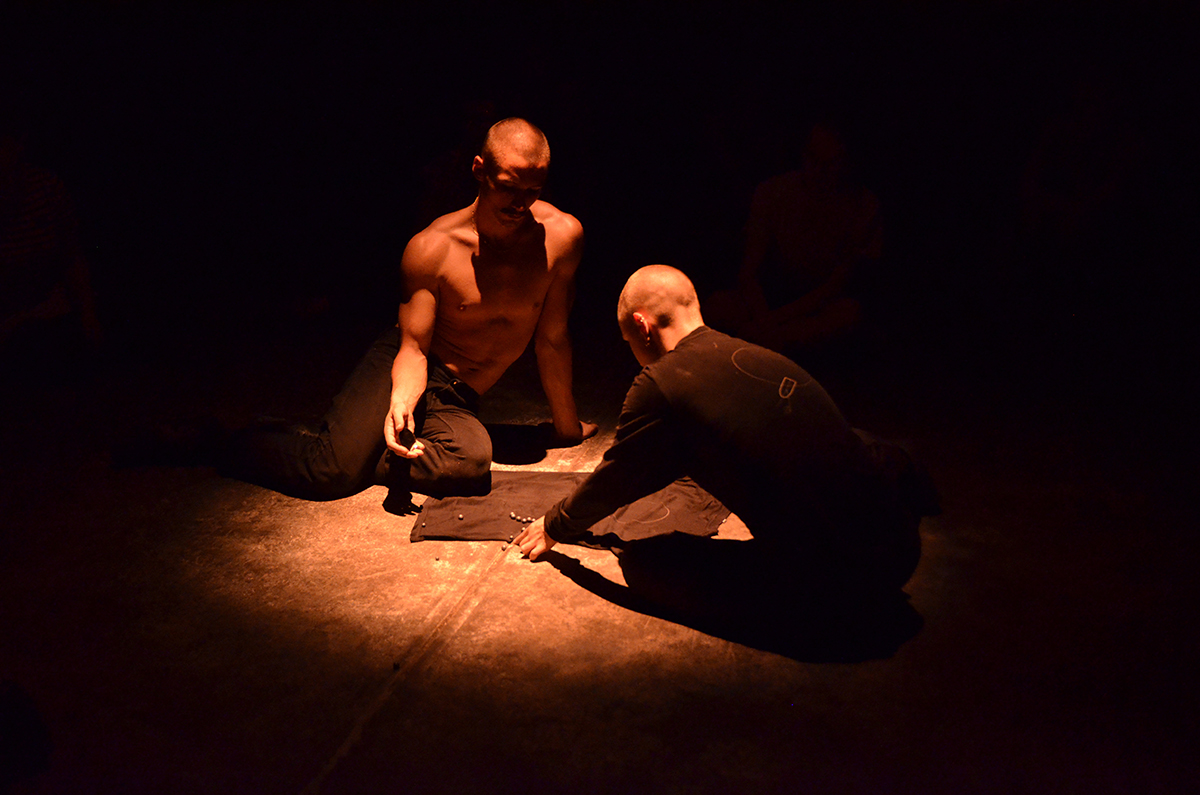
Deepspace, James Batchelor, Amber McCartney, photo Jennifer Greer-Holmes
James Batchelor and collaborators, Deepspace
Developed from choreographer James Batchelor and visual artist Annalise Rees’ two-month residency at sea aboard the RV Investigator, an Australian marine research vessel deployed to the barren Antarctic islands Heard and McDonald, Deepspace locates the bodies of its performers — Batchelor himself and Amber McCartney — “between extremities of remoteness and proximity, connectedness and isolation, certainty and uncertainty” [program]. The work’s venue is the cavernous Hart’s Mill Flour Shed, within which the audience is able to move freely as the performance plays intriguingly with our sense of perspective, by turns demanding our full awareness of the space, and drawing us in for moments of deep intimacy as the dancers’ bodies themselves become sites of exhibition.
The work begins with the dancers — both androgynously lean and shaven-headed — in the centre of the shed, hunched over as though fearful of taking up too much space. They uncoil in slow unison, then reveal palm-sized globes swirling through the air before gently releasing them to roll to the edge of the space’s concrete floor. Next, they begin a duet reminiscent of that old drama game in which two actors mirror each other’s movements as closely as possible, imperceptibly switching who is leading who at given intervals. The movement has an improvisational quality, the dancers — clad in head-to-toe black — alternatingly entwining and disentangling themselves from one another across both horizontal and vertical planes. Limbs nestle against limbs, relenting and pushing, as the dancers gradually spin out of each other’s orbits, Batchelor’s contemporary choreography taking on the more expansive movements of classical ballet.
We discover the space with them, as well as the scattered objects with which they seem to be gathering spatial and personal data: a length of rope, tied to one wall of the shed and used as ballast for experiments in weightlessness; curious, sculptural props that one moment pin the dancers to the ground, the next act as conduits for a marbles-like game. All the while, Morgan Hickinbotham’s ambient sound design pulses and thickens without ever resolving into a discernible beat.
In the work’s final, mesmeric sequence, the shed’s lights are switched off and a narrow wash of orange-coloured light illuminates the dancers, now back in their starting positions. We gather round as Batchelor removes his shirt and lies flat on his stomach, McCartney placing a handful of smaller versions of the globes along his spine. Arching his back, Batchelor sends the globes up and down, pooling them with exquisite physical control between his shoulder blades and in the small of his back. Eventually he allows the globes to spill out across the floor, a random constellation that seems to defy the dancers’ earlier attempts to bring a kind of order to the space. In a final, lingering image of personal and spatial oneness, Batchelor holds up a small mirror, reflecting light that suddenly seems golden, sun-like, onto McCartney’s face, dissolving its features.
Despite its surfeit of ideas, and occasionally arch conceptualism, I found Deepspace to be a beautiful, quietly urgent provocation to rethink our relationship with the world as we both find and remake it.
Sandpit, Eyes
Founded in 2012 as a collaboration between Creative Directors Sam Haren and Dan Koerner and Technical Director Robin Moye, Sandpit is known for its experiential, technology-focused projects in both theatre and non-theatre settings. Its latest work, Eyes — the result of a three-year research project with the Digital Theatre Initiative, and first performed at Mount Gambier Fringe in 2017 — is an immersive audio recreation of a fictional apocalyptic catastrophe, “The Great Event,” in which a terrorist dirty bomb has triggered a nuclear disaster.
The audience, situated as survivors who have signed up for an audio tour simulating the catastrophe, meets guide Matt (Antoine Jelk) in a military-style tent erected in the suitably desolate surrounds of the South Australian Aviation Museum. We are promised an exciting journey through the post-apocalyptic landscape — “the following hour of your life,” Matt tells us, “will see you asking yourself, do I have what it takes to survive? — and each handed a hessian “survival kit” containing an audio device, a blindfold and a plastic rain poncho. Putting on our headphones, Matt’s voice is suddenly underlaid with Brendan Woithe’s dramatic, Hollywood-style score. He greets each of us in turn, holding our gaze until it becomes uncomfortable. As he repeats my name back to me, a voice whispers disconcertingly in my ear: “I have a special feeling about you.”
A light drizzle is falling as we begin the tour but I don’t put on my poncho, feeling acutely conscious in a festival focused on climate change art of its wasteful disposability. We proceed among industrial refuse and abandoned railway tracks, Matt “deactivating” force fields and booby traps and guiding us across mutant-infested rapids, miming impeccably to sound effects triggered over Wi-Fi by an unseen stage manager (Lachlan Martin). Also on the tour is James (James Paul), the work’s technical manager and a target of Matt’s increasingly paranoid speculation. We’re led to a locked industrial building — Matt is in constant communication via walkie-talkie with one of his superiors, who believes a guard will let us in — but it’s unattended. Rounding the building, we find the guard, conjured via more miming and sound effects, who has been shot by a terrorist, and who Matt tries but fails to resuscitate (cue wincingly lifelike SFX of ribs snapping, flesh and blood squelching and slopping). The guard’s death, and an evermore ominous sonic landscape of distant gunfire and explosions, triggers in Matt a full-blown psychotic break. He rants about a conspiracy, and wrests a purportedly controlling implant from his own body.
Despite an impressively committed performance by Jelk, and Woithe’s slickly evocative aural design, Rachel Perks’ text and the work’s narrative framing more generally, prove both confused and confusing. With little visual information to go on, the audience is often left to disentangle its layers, both meta and otherwise, diminishing our ability to stay fully immersed. Loose threads remain — what was the source of the voice I heard in my headphones at the tour’s beginning, and what narrative purpose did it serve? — while individual moments, such as Matt’s breakdown, defy interpretation. I wondered if it was real for him or a part of the tour’s simulative framework, a question with the potential to change my reading of the work’s representation of self and agency at the end of days.
In the finale, Matt leads us to an empty field, setting off a flare and instructing us to put on our blindfolds. Emotive music swells in our ears as he speculates, in a long, existential monologue, on humanity’s place in the natural order, and our ultimate disappearance from it. “Apocalypse doesn’t mean the end,” he tells us, “but uncovering. An understanding.” In their divergent speculative futures, the works in Climate Century prompted new ways of thinking about what it means to live in the Anthropocene, a time of profound loss but also resistance and reinvention.
–
Vitalstatistix, Climate Century, Waterside, Hart’s Mill and surrounds, Port Adelaide, 8-25 Nov
Top image credit: Eyes, Sandpit for Climate Century, 2018, promotional image courtesy Vitalstatistix




























